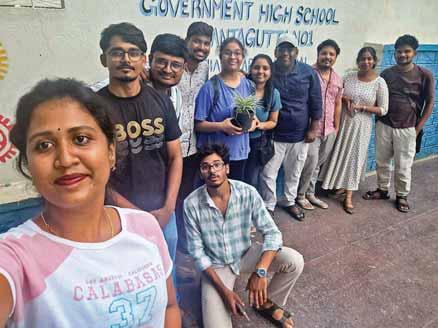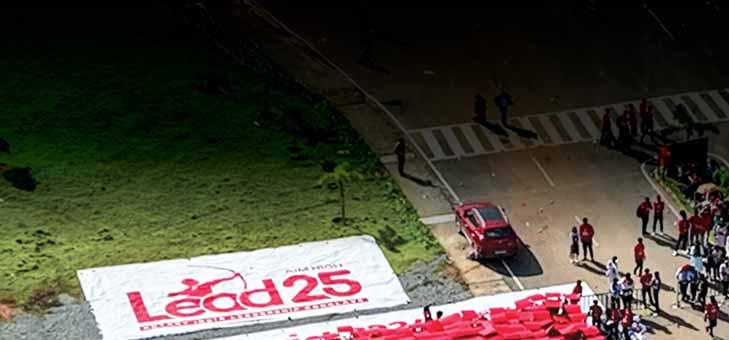
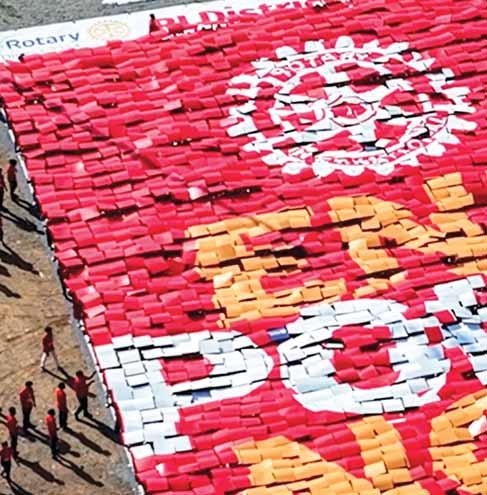
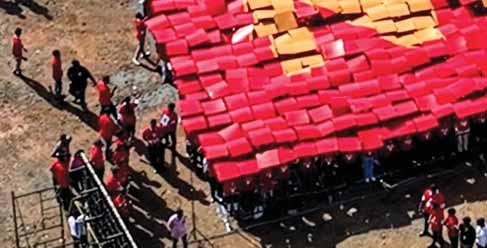



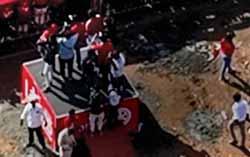










RI District 3203 set three world records as it got officially recognised by the Elite Book of Records, the Indian Book of Records and the International Privilege Records for the largest ‘human dove formation’. The symbol of peace was created to commemorate the International Day of Peace (Sept 21) as it brought together 2,975 Rotaractors and Interactors from 37 institutions who together formed a massive dove at the Revathi College of Nursing and Paramedical in Avinashi, a town near Coimbatore, Tamil Nadu.
Ther event was telecast on Zoom for TRF trustee chair Holger Knaack and his spouse, Susanne, and TRF trustee Bharat Pandya, who were at Tirupur for a TRF meet to felicitate AKS members and major donors. The leaders expressed high praise for the achievement and the spirit of teamwork demonstrated by RI District 3203.
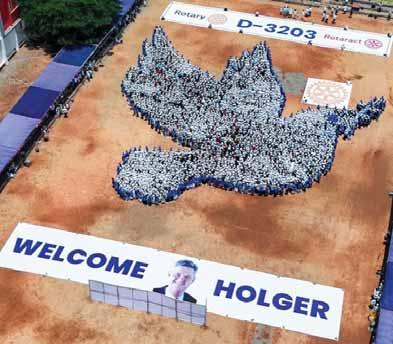
DG B Dhanasekar, District Rotaract chair Rajalakshmi and DRR T Selvavignesh
Periyanayaki, along with PDGs
A Karthikeyan, B Elangkumaran and


K Shanmugasundaram, supported and guided the team for the spectacular show. The record-making peace symbol highlighted Rotary’s dedication to promoting world peace.

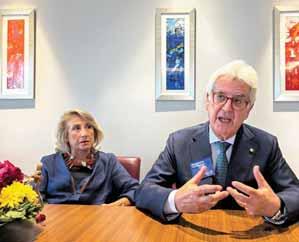
6 The quantum of service by Rotary in India highest in the world: RI Prez
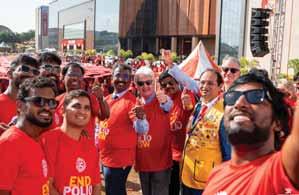
16 End Polio show wows Arezzo
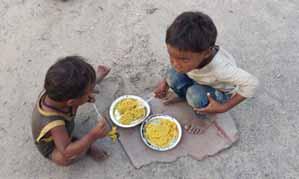
20 300 weeks of fighting hunger
On the cover: Around 3,000 Rotaractors from RID 3234 form a human End Polio Now logo in the presence of Rotary President Francesco Arezzo at the Lead25 Conclave in Chennai.
24Rose milk wins hearts for Delhi Rotaract
30 Welcome to Rotary, Mrs Mapusa
44 Nurturing lives and the environment
50Young beacons of change in Vapi
52 Rotaract wall paintings inspire students
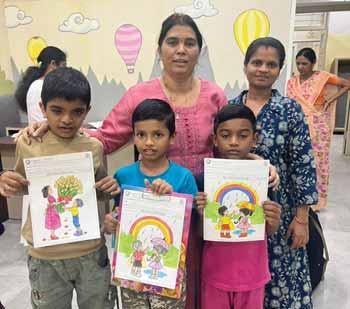
26 A lifeline for children with neurological disorders in Dhule
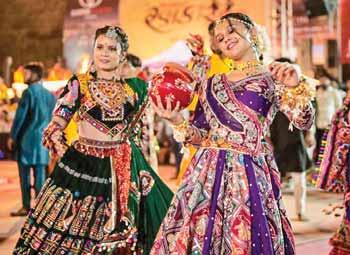
38 A sparkling Garba mela in Patan
RI Director M Muruganandam
RI Director KP Nagesh
District Rotaract Representatives 2025–26 Zone 4, 5, 6 & 7
Vishnu Raj Saravanan
Gopala Krishnan
Shashi Prakash
Kedarisetty Krishna
Raghav Milind Pagar
Udita Rajkotia Singh
Jai Singh Kushwah
Dhruv P Patel
Rajat Jain
Ruchit Harish Mehta
Deepanshu
Ritik Nagpal
Raghav Goyal
Tushar Kansal
Mahi Bhan
Dwijesh Nashikkar
Ketaki Sanjay Kulkarni
Yashwardhan Chauhan
Jitesh Bhatia
Vamshi Vinod Kumar
Athota Teja
Prajwal R
Nivas MR
Karthik U Chikmath
Janice Philip
Selva Vignesh
Jophin George
Gogul R
Dharani Prasanna G
Nazmi Mahamood
Dineshkumar M
Sathish Kumar
Kumar Shivam Das
Dinesh Gaire
Editor
Rasheeda Bhagat
Deputy Editor Jaishree Padmanabhan
Senior Sub Editor Muthukumaran V
Sub Editor
Kiran Zehra
Administration and Advertisement Manager Vishwanathan K
Designers
Gunasekaran L Krishnamurthy N Krishnapratheesh S
Send all correspondence to ROTARY
3rd Floor, Dugar Towers, 34 Marshalls Road Egmore, Chennai 600 008, India. Phone: 044 42145666 e-mail rotarynewsmagazine@gmail.com facebook @RotaractNewsIndia twitter @Rotaract_India instagram @Rotaract_India website www.rotaractnews.org
Published by Rotary News Trust from Dugar Towers, 3 rd Flr, 34,Marshalls Road, Egmore, Chennai 600 008.
The views expressed by contributors are not necessarily those of the Editor or Trustees of Rotary News Trust (RNT) or Rotary International (RI). No liability can be accepted for any loss arising from editorial or advertisement content. Contributions – original content – is welcome but the Editor reserves the right to edit for clarity or length. Content can be reproduced, but with permission from RNT.







The last few weeks have brought heartbreaking news; the first was the passing on of SangKoo Yun, who was nominated RI President, but stepped down due to a terrible health condition. His loss has been captured in this issue with moving, heartfelt tributes by two past RI Presidents – KR Ravindran and Shekhar Mehta - who knew him well.
Another great tragedy was the demise of the swoon-worthy Hollywood icon Robert Redford. Almost every woman of an era gone by who watched him on the silver screen, which he lit up with his magical smile, had a crush on him. And almost every man admired and envied him. Who can forget the dapper Sundance Kid in the space he shared with another great Hollywood legend Paul Newman in Butch Cassidy and the Sundance Kid (1969)?


the human condition, the complexities of life, the world around us.”




Redford had a quiet charm and natural grace, and despite being a Hollywood celebrity, his friends say he displayed humility in all he did. His co-star Barbara Streisand in the movie The way we were, who had a massive crush on him, described him as a “smart private, shy but self- assured intellectual artist… whose work was skilfully subtle, restrained and yet deeply emotional.” But, in the times to come, he will be remembered for being much more than a stunningly handsome great actor. Because he was much more than that.
He was also a keen listener, progressive thinker, a fierce environmentalist and a diversity warrior. Unlike most successful superstars he did not bask in his success to snuggle into an uber luxurious life. In 1981 he established the Sundance Institute to give new and struggling artists the platform to develop their skills, and give expression to new, bold and independent work. As he himself said, artists of every hue needed “to have the freedom of expression to tell our stories, in our own way about
And most, important, as an influential celebrity, he spoke up for what was right, unlike our Bollywood and other Indian film industry greats who have forgotten what it is like to have a spine. Not in a shrill voice, but firmly and with quiet and restrained dignity. While accepting an Oscar for lifetime achievement in 2002, addressing his peers in the audience, which included all-time great actors and directors, he talked about the “solid and healthy” film industry they shared. But he warned that in the coming years, they’d “have to make sure to embrace the risks as well as the sure things, to make sure that the freedom of our artistic expression is nurtured and kept alive, because I believe that keeping diversity alive will help keep our industry alive.”
Next, he expressed his concern for the “sea change” that the world they lived in was undergoing. “And as we all struggle to find our way in it, to get a grip and make sense out of the chaos and the destruction and the tragedy, one word that emerges is the word freedom… its importance, its rarity…and how fortunate we are to have it. Such freedom is a gift and not to be taken lightly. The glory of art is not only that it can survive change, but lead it.”

Ponder over his words, and the position of influence in the world of art that Redford held, when he uttered them. They are the words of a thinker, a leader… they are over two decades old, but even more relevant in our world which is fast spiralling into a deeper chaos, destruction and darkness…
Rasheeda Bhagat


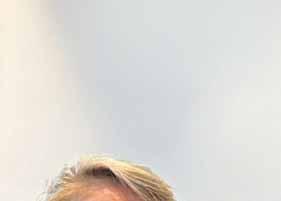

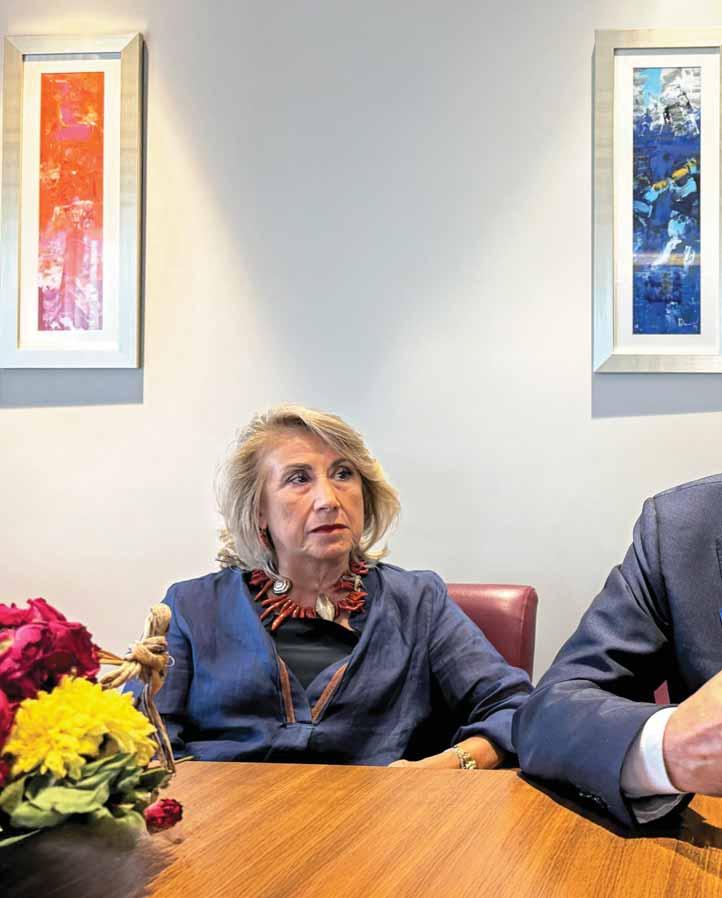


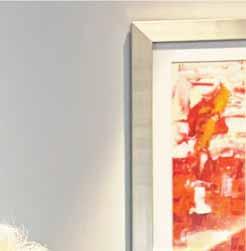
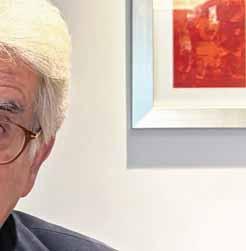

You expect any Italian male to be charming… for after all charm is built into the Italian DNA. RI President Francesco Arezzo does ooze charm… but he is much more than charming… he is both cerebral and witty, but at the same time so easy to talk to as he wears his power lightly. He may falter a little while searching for difficult English words, or stumble a bit pronouncing the long ones… but his disarming smile and spontaneous laughter more than make up for it. When he delivers a speech, it takes a couple
of minutes to cut through the heavy Italian accent, but once you’ve done that, its content leaves you thinking.
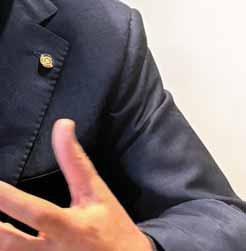

I catch up with Arezzo, and his genial, eversmiling spouse Anna Maria, on the sidelines of the Lead25 Conclave in Chennai for an interview for Rotary News. The time given is 20 minutes, but the couple end up discussing for 55 minutes their Rotary journey and sportingly posed for pictures in the limited space of their hotel suite!
Having done several olive oil tours around Europe, Turkey and North Africa, I quiz him on his family farm in Sicily, Italy, producing olive oil for 200 years. “That farm is close to my heart because my mother, father of my mother, grandfather of my mother… were involved in



the production. But today, more than me, Anna does all the hard work.”
Arezzo grew up in Sicily where his family has lived for 800–900 years. “We are completely Sicilian. I was born in a little city of 70,000 people… for you it’s a very tiny city. My childhood was great; the 1960s and ’70s were a wonderful time to be in Italy.”
He lost his father, a radiologist, at 10, and grew up with his mother. After training as a dentist elsewhere in Italy, he returned home to open his practice
as a dentist. When and how did he meet Anna? “I met her when I was 2 years old,” he grins. “Our families are very close and I’d call her parents uncle and aunt! We grew up together!” So, who was the one who proposed? With a mischievous twinkle in his eye, he says, “Well, what can I say; she did a very strong campaign!” They got married in Oct 1979, and have two daughters and two grandchildren, one named after him and the other after Anna. “Just like you do in India,” quips Anna.
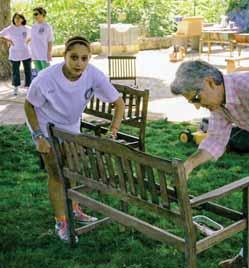
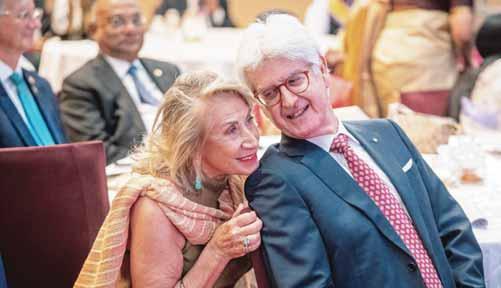
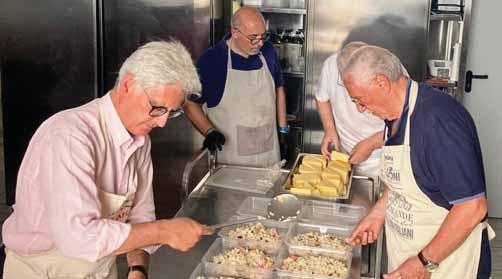


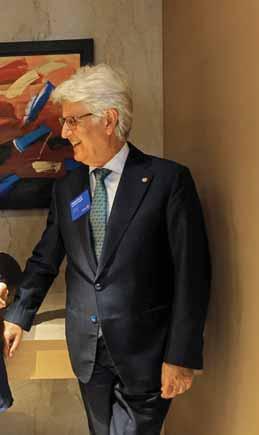

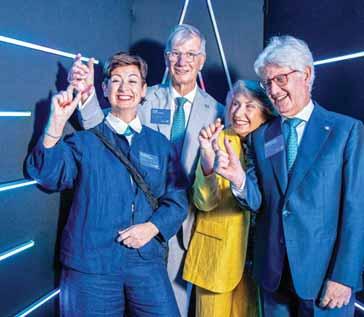


Yes, there are so many similarities between India and Italy, I comment, like family bonhomie, sharing food when dining in restaurants etc. “Both countries have a long history and culture, so we are very similar… but we are also very different in some aspects,” he adds.
Asked when and why he joined Rotary, Arezzo says that soon after returning home after his education, his father’s friends, members of the Rotary Club of Ragusa, proposed his name in 1989. “I have to confess that when I joined Rotary, I didn’t know exactly what Rotary was. But as all friends of my father, and many people in the city I knew, were members of that club, so when they proposed my name, it seemed like a good thing
to join. But as usual, you begin to understand what Rotary really is when you become club president. Then you understand how complex, beautiful and useful Rotary is for the community.”
It took him 10 years to become club president and another 10 to become governor, and he gradually developed “a network all over Sicily, Italy and the world. I met a lot of people who were very interesting, very passionate and very close to my soul! And now I have many of my best friends coming from Rotary. But,” he adds with a mock sigh, “only one thing went bad; I met John (de Giorgio),” pointing to his aide seated in the room.
So does he harass or bully him, I pick up the cue. “Oh yes, he tries everyday,” Arezzo grins, adding that when he was governor, he met de Giorgio, who was then president of

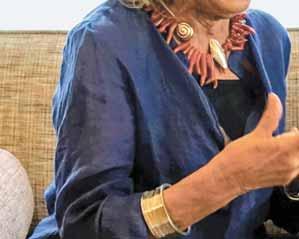
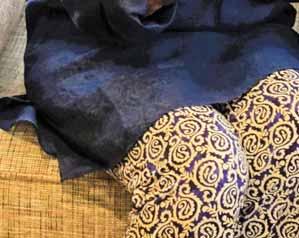
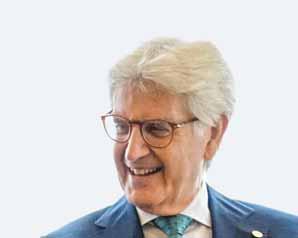
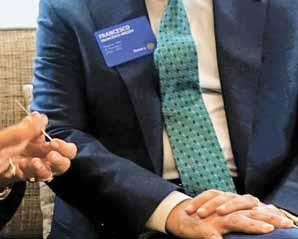
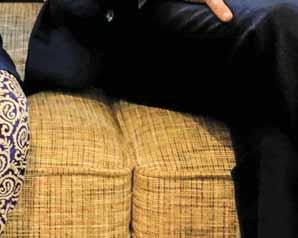




Are you a foodie? Your favourite cuisine.
of your childhood. So I like the a


many traditional dishes. What is holiday as he is sain of the Easter, and so on. An I love all that food!

It is very simple. You like the food of your childhood. So I like the cuisine, not of Italy, but Sicily… yes, pasta. We eat a lot of fish, and many traditional dishes. What is amazing in Italy is that we have a traditional dish for every holiday... Christmas, St John’s, as he is saint of the city, Easter, and so on. And
Do you cook, can you cook? seated beside leans b and shakes her head vigorously and says: He makes mess... he likes very much to coo but I have to clean!” John de Gio in He is a better President than a cook!


Anna, seated beside him, leans back, and says: ‘Oh please!! He makes a mess... he likes very much to cook, but I have to clean!” John de Giorgio, chips in cheerfully: He is a better
Indian food, tolerance of spice: I liike k Indian fo f od. I like but to t o much!

I do like Indian food. I like spicy, but not

I am Catholic and go to read about other religions. I know just a bit about your books like the
Reading; all-time favourite author:
Orhan Pamuk (Nobel Prize for Literature in 2006), and the Russian writer Anton Chekhov. I have all of Pamuk’s is another great book... a little
Religion: I am Cath t olic and go to ch churrch h on S Sundndays. But I like to r read abo b u ut t oth t er I know s a bit abo b ut you o r books like th . all-time favourite autho I loove v to reead a I read a lot of Pi P randelelloo, a wrriter from Sicily. I loove ve to re r ad the Turkish writer O Orhahan Pamu m k Prize for Li tu ture in 2006 0 ), ) and the Russian wr An Antoton Ch C ekhov. Pam bo book o s at hom o e; is anonother e great book... a litt st straang n e bu b t s so beautiful!
Opera r . I also like cla ca cal mu musi s c. c

Music: Opera. I also like classi-

Instruments: Oh no, but in my fam a i ily my moth gr g an andmdmot o her and

Oh no, but in my family my mother, grandmother and


aunt played the piano… my brother plays everything — trumpet, guitar… you name it! I play… just the bell of the house! (laughs heartily).
Favourite travel destination: Not the beach; I have the beach right at home. I like to travel to historic places, where there is a lot of history and culture. I like to go to the temples in India, because there you can find out about the culture of the place. Sicily is small, compared with India, but it is a continent for culture. You can find the ruins of Greeks, Romans, Arabs, Byzantines, Normans here. You can read all that history while walking through the city.
Most favourite city in the world: Naples; it is such a wonderful city… it’s a big city, not so rich, a bit abandoned but its beauty is the ancient vibe it has... the atmosphere. Also, the people are very friendly and likeable. The food here is so good; the pizza was born here and the music in Naples is outstanding. The beauty of Italy is that even in a city no one knows, you can find a beautiful church! The beauty is spread all over the country... it is not concentrated, like for example, in France, it is concentrated in Paris.
Dream for Rotary: My dream is simple… to finish the campaign to eradicate polio and participate in the Nobel Prize… winning it is very difficult, but at least to participate in the process would be so good.
After polio, what: I told you I like Naples. In Naples the people are very superstitious… so it is bad luck to think now on what to do after Polio!
RC Malta, which forms a part of the same RI district. “We became good friends very fast!”
Iask Arezzo to spell out his vision and priorities for Rotary as RI President, even though he had virtually no time to plan his year. He responds: “Well, I just had a few days before I became President… such a short time to prepare. There are some things which are very important for Rotary, two of them are historical. One, the eradication of polio. It is so vital for our organisation. India did a great job, and was able to eradicate polio, doing something they said all over the world was impossible! It was a great, great job.”
But now Rotary needs to finish the job as polio cases still remain in two countries, “where we are engaged — Afghanistan and Pakistan — and we have to complete the job.”
The second one is the problem of membership “which probably you (India) ignore because you are growing. Tomorrow (at the Lead25 Conclave in Chennai) they are going to present 250 new clubs, something that is impossible in Europe. Membership all over the world is a big problem, so that is my second priority.”
Another priority, or concern he has, is related to “the suffering caused by war. It is difficult for us to obtain peace between two countries that are fighting, but my aim is to work for peace.” And this Rotary can do in a myriad of ways; “we work for peace when we give to people fresh water, sanitation, good and clean environment, education… all these are small but definite steps towards peace. Together we can create, and we are creating, a great network of Rotarians who can enhance better
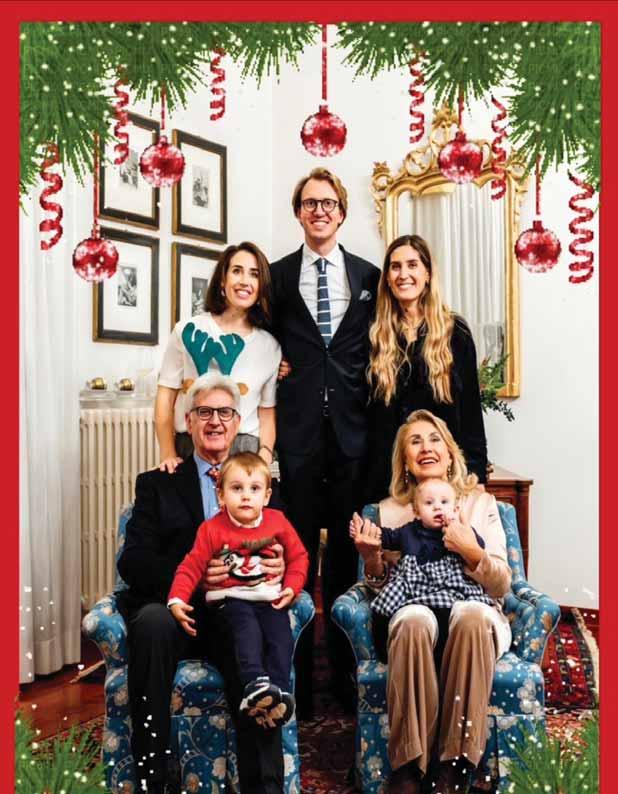


comprehension between people all over the world.”
RI President gives the example of his visit to India, where he has met not only existing friends but made new ones. “For me, India is a country where my friends live. If we have millions of people around the world who can comprehend the feelings, problems and challenges that people in other countries near them face, it is another small step towards peace. We have to enhance the comprehension between people. That is my aim... to improve what we can do, and have pacifist dialogues between countries.”
Asked about Israel and Palestine, he says, “Yes, that is another big problem. We cannot stop the war but we can help people to connect, to speak to each other and have a better comprehension, because very often war is the result of fear, and fear is
the result of ignorance. Because I am ignorant about another country, I fear it and its people. But if we can get to know each other, connect with each other, we will realise that they have the same dreams, the same problems, the same souls as we have. If we can meet, sit together and talk, we can have better understanding of one another. We can do small things, but we have to do them.”
These three are his main goals during this year…. “or should I say the remaining months? Because an RI President usually has one and half years to plan. But I spent two months to understand what I should do!”
So did he feel disadvantaged or pressurised, I ask him. His answer tells us why he has reached the top post in RI. “No, I was actually

If millions throughout the world can comprehend the feelings, problems, challenges that people of other countries near them face, it is another small step towards peace.
excited… and when you have something that is more difficult to do, you are more motivated.”
But he admits that “now that my term has started, I understand that to have one year to prepare would have

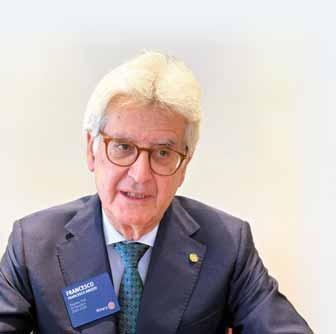
Howcan we attract younger members to Rotary? Take the example of Europe; very often we remain isolated in Rotary. We create Rotaract clubs and then abandon them. We don’t want to mix with them, because they are too young. But we have to work together with them. Why don’t they become Rotarians? Because they don’t believe in Rotary. They don’t believe in us, because we don’t work together and we don’t know each other. We can have more Rotaractors become Rotarians if we admire and understand each other, and work together. We must ensure that they work with us in every project and should be involved much more than is happening today. And the same is true of Interactors.
For instance, I’m told I will be meeting 2,000 Rotaractors tomorrow; imagine this many Rotaractors in one room! We don’t even have this many Rotaractors all over Europe and here you have them in one room. That’s an incredible number! But at the same time, you have to involve them and make them feel a part of Rotary. To elevate Rotaract is not enough, we have to engage them and work together.

Whenasked about Anna’s role in his Rotary journey and if she has been resentful about Rotary taking away so much of his time, President Arezzo says, “It is impossible to be an effective RI President, and reach this position, without the support of your spouse and family. It’s a great commitment, and very time consuming. So I need to be supported by her in many, many ways, and I have found that support from her.”
Adds Anna jovially, “I organise his luggage.” He responds: “I have to go here and there, and it is amazing how in a small suitcase she will put a lot of things and when I have to return and repack the bag I cannot understand how she managed to put so many things there. It seems impossible!
Has Anna ever resented Arezzo giving so much time to Rotary?
“Oh yes, because I am alone at home and I sometimes find it difficult to manage everything. Officially, I have no career but I really do a lot work, I work for the entire family.” He chips in: “I always say I am an olive oil producer, but in reality, it is she who is the olive oil producer because I don’t have the time to look after the farm. We have a small hotel; again,
been much better. But I have to do what I can!”
Does the shorter span make his job that much harder? “It means more hours of work. The life of any RI President is very busy; you have to travel around the world, you have
I don’t have the time. It is she who runs the hotel. She does a lot of things….”
Now that he has reached the topmost position in Rotary, is she happy? “Yes, I’m very happy, but at this moment I am a little confused. There are a lot of things to do, so many programmes to attend... because it was so fast, we didn’t have time to prepare,” sighs Anna.
Adds Arezzo, “We had to leave our home, farm and my office, and so fast…. Yes, we had absolutely no time to prepare. Luckily, at the office, we have my elder daughter, who is also a dentist and works with me… when I said I was elected RI President… she began to cry.” From happiness, I ask: “Well yes, but also because she was worried, that now she would have to handle the office all alone!”
The last word should go to his aide de Giorgio, who describes Arezzo as “a very humane person. His relationship with people is very good and that is appreciated by Rotarians. At the same time, he is also very humble as a person… a nice combination.”
“We’ve been friends for 15 years… and have the same problem — we have two daughters of the same age,” smiles Arezzo.
to take pictures with the Rotarians (laughs heartily!) That is one of the main jobs of the president! I told RIDs Nagesh and MMM that I am here for the Rotarians, to speak to them, meet them and take pictures with them. I have to motivate them

so I am available to them. I am very happy to meet people from the Rotary family.”
This was Anna and Arezzo’s third visit to India; the first was when he was RI President’s representative at a meet in Lucknow, and the second during the Rotary Centennial in India celebrations in Kolkata. Expectedly, Anna is disappointed that she had no time for shopping! “Both of us love the culture, history and food of India and hopefully when we come for the Zone Institute this November, we will have some time for all this,” he says.
“Oh yes, I would love to go shopping in India and I have told him to give me some time for shopping during the next visit,” Anna says firmly!
Coming to Rotary in India and the kind of community service projects that Rotarians do here, Arezzo says, “The good thing, the very good thing, is what we saw earlier today… the number of projects that were launched is unbelievable and in so many different fields.


We saw 100 pink autos for women… through this you are giving 100 women the opportunity to earn and maintain their livelihood. It was an excellent project and so moving. In the House of Friendship there were so many projects on health, water, sanitation. The quantum of service that Rotarians in India do is probably the highest in the world. It is amazing.”
The other thing is the money the Rotarians in India give to The Rotary Foundation; it is huge. “Yesterday we had 29 new AKS members; that is amazing and probably possible in the US. But this is impossible in other parts of the world. In Europe it is absolutely impossible. So that is great. It is a vibrant Rotary in India with a lot of good
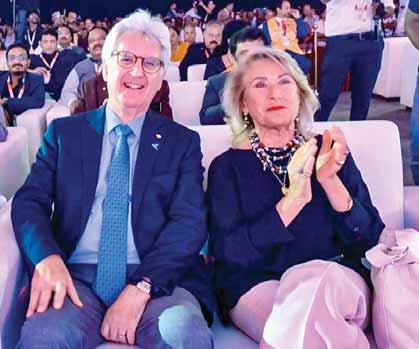
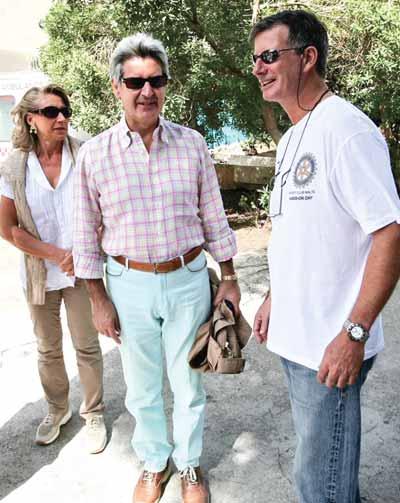
projects, a lot of enthusiasm and passion among the Rotarians.”
What about the negative aspects the last few RI Presidents have been talking about? “What is bad in India? In some places Rotarians are fighting each other. When we are in a Board meeting, we receive a lot of complaints about elections. In Evanston, if 10 complaints come, eight are from India. This is a problem. The level of internal fighting in Rotary in India is something that we have to find a way to reduce. It is a pity, because the Rotarians here are so active, enthusiastic and passionate.”
Asked for a possible solution, Arezzo shrugs and says, “I don’t know. It is not easy to find a solution. It is a cultural problem and we have to work on the Rotarians to convince them that there is room for everybody. If you don’t become a club president or governor this year, you can wait. It is not such a big problem. But it is not easy to find a solution. The only way is to talk to the Rotarians and convince them!”
by Krishna Pratheesh

V Muthukumaran
An awesome spectacle of the formation of the End Polio Now logo by 3,000 Rotaractors from RID 3234, a Guinness Book attempt, wowed RI President Francesco Arezzo on a bright Sunday morning in Chennai. “It is very impressive to see the EPN formation by such a large number of Rotaractors… only in India we can see such a vibrant Rotaract,” he excl aimed.
This EPN display, held at the Lead25 Conclave, visibly delighted Arezzo and his wife Anna Maria as they watched a massive gathering
of around 5,000 Rotaractors for the record-making attempt to create awareness on Rotary’s End Polio campaign worldwide. The RI President said that the whole of Italy would not have 3,000 Rotaractors, “whereas a single Rotaract district in India has attempted a Guinness Record. Rotaractors find new ways and ideas of doing projects, which may seem impossible for Rotarians.”
Emphasising that Rotary has a rich legacy, proven integrity, leadership and fellowship traits, which will be passed on to Rotaractors, he urged the youth
brigade to “show the way forward to Rotary. I wish all Rotaractors join Rotary clubs soon,” he said.
“The youth are changing the world… just a single post on social media by them is enough to create a big churn. The speed and power of youngsters are driving change. I enjoy Rotary because of my entry as a Rotaractor,” said RI director M Muruganandam.
Citing Mahatma Gandhi’s words: Be the change you want to see in the world, he said Rotaractors are critical for the Rotary wheel to move for yet another century. Only by taking responsibility, “a man is respected as a father in his family, and a leader in his community. From Rotaractors, you have to become Rotarians.” Youth should aim to achieve big in their lives, he said, quoting former President Abdul Kalam: “Your entry may be unnoticed, but your exit must be remembered all time.”
Stating that both directors, Muruganandam and he have set a
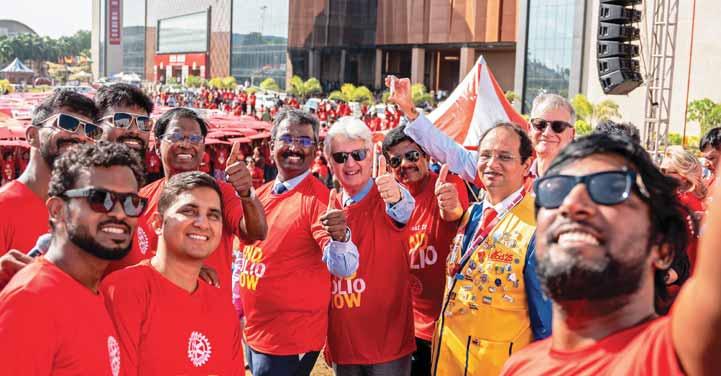
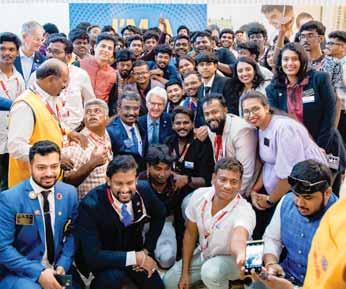
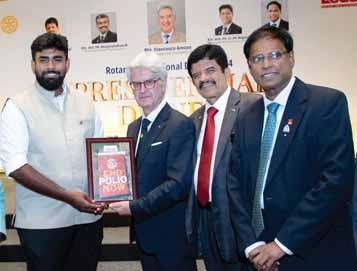
target of $5 million for the India zones for the Polio Fund this year, RI director K P Nagesh said a cricket tournament titled the Rotary Premier League will be organised for all the four zones to raise funds for this cause. He complimented the RID 3234 Rotaractors “for a grand show in front of RI President Arezzo, thus projecting the strength of Indian Rotaract clubs.”
It was a proud moment for RID 3234, said DG Vinod Saraogi; service projects worth `250 crore were launched at the inaugural session of the conclave. Of this,
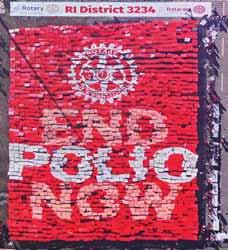
‘End Polio Now’ formation by 3,000 Rotaractors.
`40 crore worth projects will be executed by RID 3234; this includes autorickshaws gifted to 100 women under Project Pink Auto. They are being trained not only in driving but also martial arts, communication and personality development. The project was funded by a mix of CSR grants, club contributions and other donors, he said.
Recalling the birth of Rotaract in 1968 with the formation of the RAC University of North Carolina, Charlotte (US), IPDG NS Saravanan, RID 3234, pointed out, “we all know the capability and potential of our Rotaractors, they are the energy boosters for Rotarians.”
Last year (2024–25), the district’s Rotaract clubs contributed $33,373 to TRF.
PRID C Basker noted “65 per cent of India’s population is below 35; our country depends on its youth. Our Rotaractors have once again demonstrated, through their End Polio display, the trust Swami Vivekananda had placed on them when he said, ‘my faith is in the young generation’.” Rotaract was formed by RI for global youth to “learn, lead and
bring change in their communities. India, with the largest numbers of Rotaractors and Rotaract clubs, is the future of Rotary,” he said.
DRR Sathish Kumar said that it was “a once-in-a-lifetime opportunity for district Rotaractors to perform in front of RI President Arezzo,” and thanked DG Saraogi for his support in staging the human formation.
The EPN logo formation is a branding exercise for district clubs and will create awareness on the global efforts of Rotary in eradicating polio, said Srinivasan Balaraman, EPN coordinator, RID 3234. “It was a great experience to anchor the entire formation,” said Britto Manohar who coordinated the event.
A past member of RAC Loyola College, he had earlier anchored two Guinness Book attempts by Rotaract — world’s largest hand formation (7,000 members) and ‘My Flag, My India’ display (50,000 Rotaractors and public volunteers.)
Sharing her experience, faculty coordinator D Monika from A M Jain College, Meenambakkam, said “the young generation today is selfcentred. Events like the End Polio display by Rotaract bring out the humanity, service-mindedness, along with leadership qualities, in them.”
Jaishree
Around 20 Rotaract clubs of RID 3250 actively participated in a mega district project aimed at maternal and child well-being across Bihar and Jharkhand.
Some clubs organised lectures by obstetricians or gynaecologists in primary health centres for pregnant women on pre and post-natal care, infant care and lactation techniques, and breastmilk benefits. Few other clubs organised multiple webinars.
“Several Rotaractors volunteered to
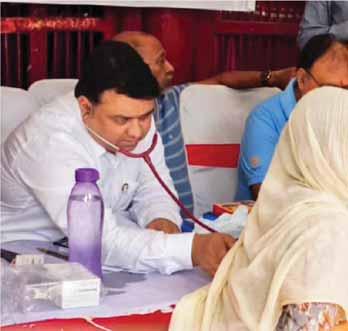

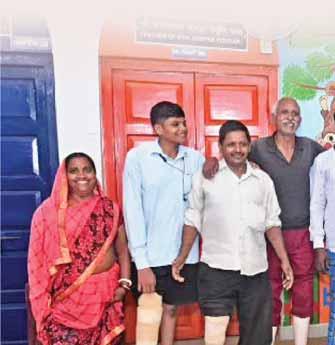
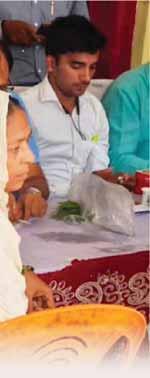
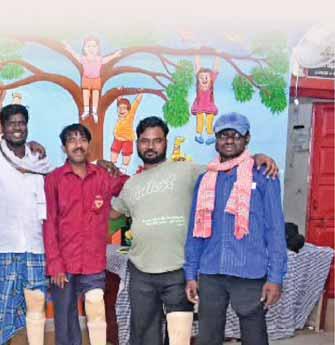
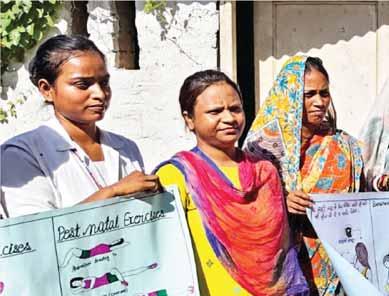
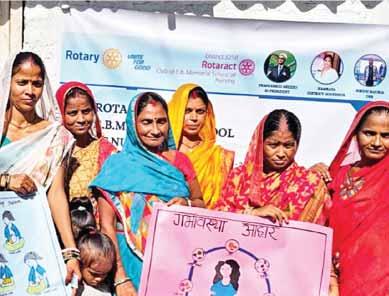

provide polio drops and helped with vaccinations in special camps the clubs had organised in villages,” said Palak Nayyar, the chair of the District Maternal and Childcare Committee.
Funds were raised through social media campaigns to provide kits for newborns and the mothers. “Our Rotaract clubs visited villages and semi-urban localities to distribute infant kits worth `50,000 to new mothers at the government hospitals, and provided health beverages to pregnant and new mothers,” she said. The kits included two sets of
dresses, napkins, talcum powder, a hair brush and a rattle. Essential hygiene kits, baby care products and informative pamphlets were distributed to expectant mothers and families with young children.
The Rotaract Club of Steel City had organised an awareness session on menstrual hygiene at the Girls High School in Jugsalai. Rtr Rishu Ranjan, a certified menstrual educator at Menstrupedia, who has educated more than 30,000 girls on menstruation, shared valuable insight with around 170 girl students on topics
ranging from maternal care, child nutrition, menstrual hygiene and preventive health practices. It aimed to empower adolescent girls with the right knowledge, laying the foundation for a healthier future generation. “Our aim was to empower the students with knowledge and confidence to take better care of themselves and to spread this knowledge among their families and communities,” said Palak.
At the maternal and child health awareness camp organised by the Rotaract Club of Buxar, medical check-up was conducted for 90 women
and children, and essential medicines were distributed. The club engaged experts to talk to them on maternal nutrition, child immunisation, and basic hygiene practices.
Among the other impactful services done by Rotaractors in the district was a mega artificial limb distribution camp, organised by the Rotaract Club of BIT Sindri in collaboration with RC Dhanbad. A total of 105 artificial limbs and assistive devices were distributed over the three-day camp held at the Jeevan Jyoti School, Bekarbandh.
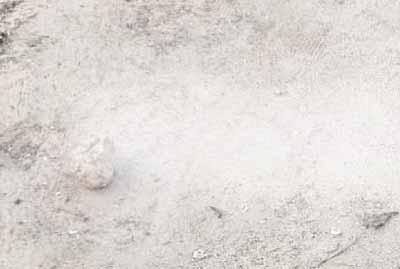
Kiran Zehra
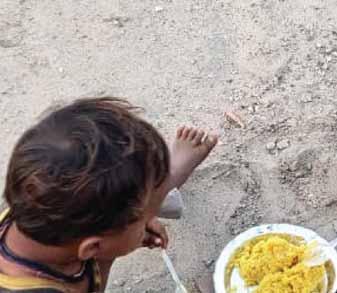
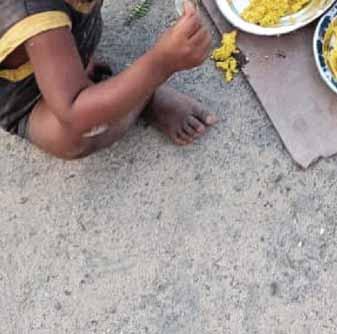



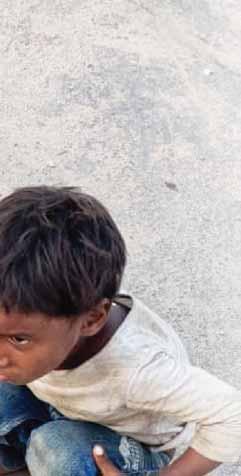
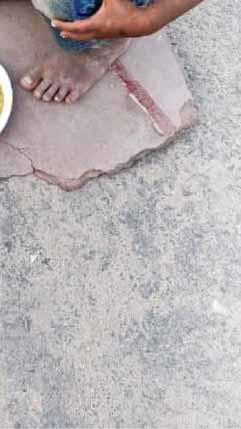

This initiative began with a question — “Why should anyone sleep hungry?
The roots of Project Nivaala (a mouthful) go back to the early days of our club, when the RAC Ahmedabad Midtown, RID 3055, was started by the engineering department students from the LJ Institutes. We were students, young, energetic, and driven to create real change,” says Vikas Gera, the club’s past president.
As part of the institute’s social responsibility efforts, different departments were assigned weekly service initiatives. The engineering department was responsible for Sunday activities, and for two years, the students passionately participated in distributing meals. The turning point came when Gera asked his club members, “Why not take this beyond the campus? Why not make it a full-fledged Rotaract initiative?”
He approached the Head of the Department, and soon after, “our members identified underprivileged areas across Ahmedabad where hunger was a daily reality.” Every Sunday the club began serving meals in those areas. The expense was completely taken care of by the members of the club. “We would procure raw materials, collaborate with the LJ canteen to cook fresh food, and then our members would personally distribute meals, ensuring not just food, but dignity, smiles, and hope were also delivered,” says Gera.
ended, our members repurposed it into the official Nivaala Van, which is lovingly driven every Sunday by Niraj Kaka, the security guard at LJ College and now an irreplaceable member of our Rotaract family.”
Even the pandemic could not stop their compassion. “Just a year after Nivaala began, COVID-19 struck the world. Streets emptied, life paused, but hunger didn’t. While everything else was shut down, Nivaala continued,” he smiles and adds “with masks on, courage in our hearts and food in our hands, our club members continued serving consistently, fearlessly, and responsibly.”
Unfortunately, the original Nivaala car caught fire. “But we were determined to keep the project

One of the most important parts of Nivaala’s journey was the “Garage on Wheels, an old car refurbished by the engineering students of my college for an academic project. Once the project

going. Food was delivered through members cars and on the club’s Charter Day in 2024, we proudly unveiled a brand-new Nivaala Van.”
“Hunger doesn’t wait, neither do we,” says Savan Barbhaya, the current president and adds, “whether it is 45°C hot, monsoon floods or a pandemic curfew, our volunteers show up. We’ve promised Ahmedabad that every Sunday, someone will eat because of Nivaala.” Over time, that small act grew into a weekly commitment. Today, around 80 people are fed every week—including the elderly, children, homeless families, and migrant workers. To make it sustainable, the team also collects untouched surplus food

A participant at the badminton tournament.
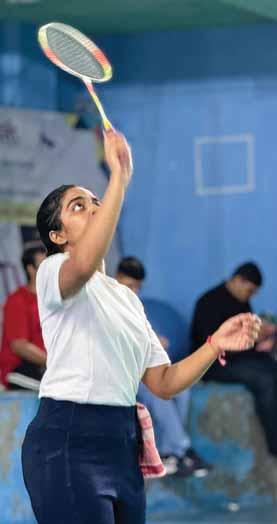
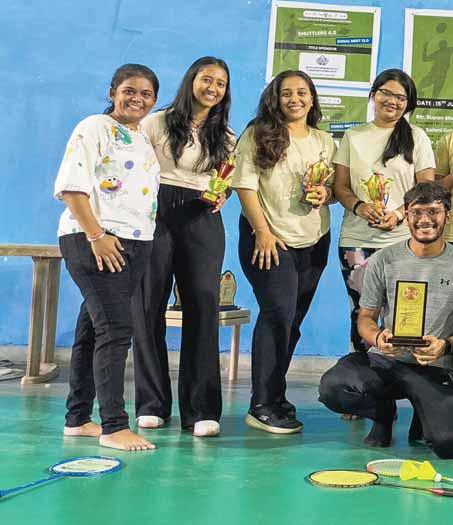
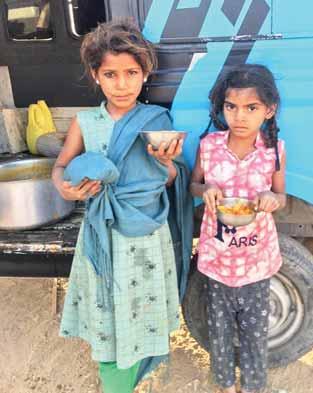
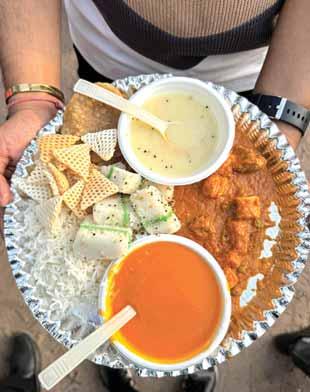
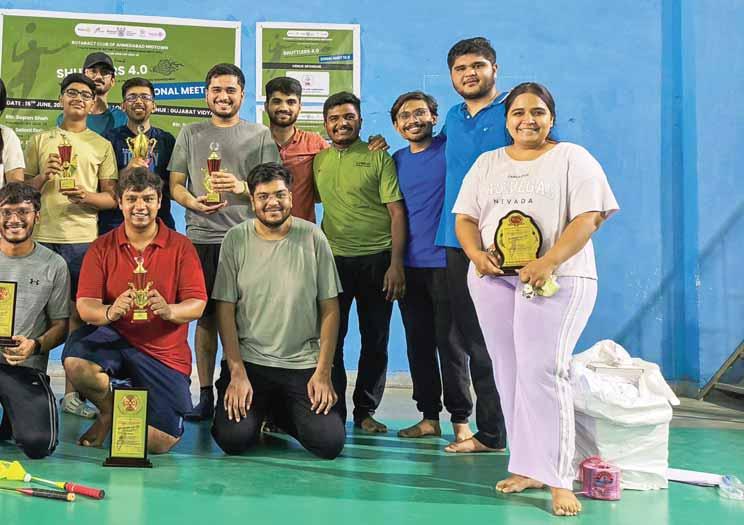
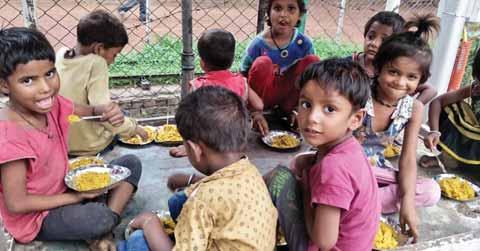
from weddings, hotels, and social gatherings.
The project runs on club funds, crowdfunding, and small donations. Together, Rotaractors have raised more than `5 lakh and put in over 3,500 volunteer hours. Club member Supan
Shah says “the experience has been as important for us as it has been for the city. It’s not just about food, it’s about learning to show up for others.” The initiative has completed 300 weeks in a row, serving more than 25,000 meals. The club now plans to scale up, aiming
to serve 1,000 meals a month by 2030 through partnerships with NGOs and businesses. But for both Shah says, “the focus remains on consistency.”
“On a recent Sunday, an elderly man accepted his meal packet with folded hands, whispering a quiet ‘thank you’ before settling down on the pavement to eat. For us that moment said it all. Nivaala isn’t just about feeding people. It is about making sure no one is left behind,” he says.
Another initiative by the club, Shuttlers 4.0, turned a badminton tournament into a festival of sport and spirit. “With over 60 players in singles and doubles and a buzzing crowd cheering them on, it has become one of our most vibrant and celebrated projects of the year,” says Savan Barbhaya.
V Muthukumaran
Afour-year-old Project Chabeel Seva that offers chilled rose milk to the public as instant refreshment from the scorching heat of May-June in the national capital has boosted the public image of RAC Delhi Dynamic Leaders, RID 3011.
Club ambassador Navdeep Singh Oberoi says, “we adopted this summer relief project from RAC Young Visionaries and expanded its reach. Last June we distributed around 3,000 litres of rose milk to 10,000 people… they range from daily wagers and street vendors to
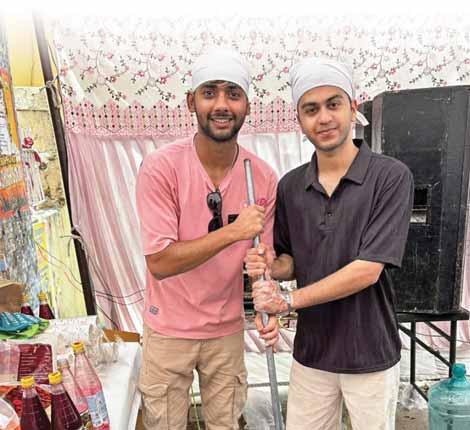
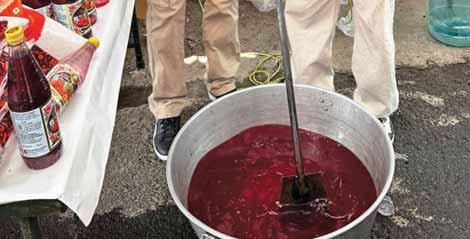
students and professionals. In fact, anyone exposed to the hot sun at the Janakpuri neighbourhood was given the refresh drink.”
Oberoi along with past presidents and members of Rotaract clubs from RID 3011 and other districts got together and formed the Rotaract Club of Delhi Dynamic Leaders three years ago. “We are a group of 52 Rotaractors drawn from diverse sectors with a good mix of college students. All of them are involved in our service projects in one way or the other either through donations in cash, kind or effort,” explains Oberoi.
For Project Unnati (progress), being done since the club’s inception, the club has tied up with seven city schools and 12 residential colonies, “from where we collect old notebooks, sparsely-used stationery items, newspapers, magazines and discarded household items through a scheduled exercise. The collected discards are recycled through a local vendor who creates new notebooks, pens and other eco-friendly utility pieces.”
After taking delivery of the new products, “that are handed over to us twice over every three months,” the Rotaract teams with the help of 2–3 NGOs distribute them to children at the underserved communities. “Over the last three years, not less than 4,500 children would have received our largess which will help them in their education,” says Oberoi. They don’t set targets for Project Unnati as it is being carried out throughout year, “and we are still expanding
our collection base by adding more schools and neighbourhoods for a bigger recycling process, that will fetch us more school essentials for poor children.”
Old bedsheets, pillows, clothes and home textiles are collected from houses across Delhi and given to a skill development centre being run by a rehabilitation home near the Bangla Sahib Gurudwara, Connaught Place, Delhi, under Project Eco-Sevika. “We have donated five sewing machines to the skilling centre where around 10 women take our raw materials to stitch eco-friendly bags for which we pay ` 120–150 per piece,” explains Oberoi. Till now, they have delivered over 500 bags which were later marketed by the Rotaractors.
Through tie-ups with multiple companies across India, “we have done 40 blood donation camps for their staff and factory workers at Ready to serve rose milk.
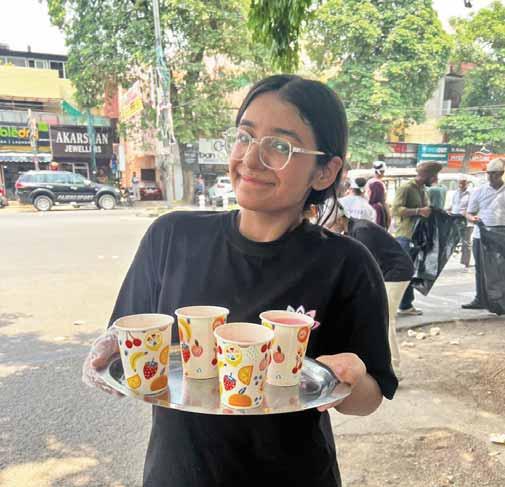
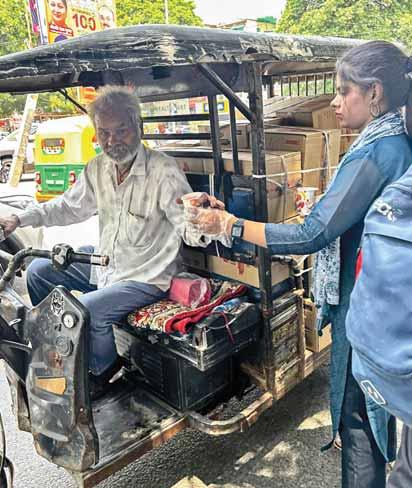
their site. In the coming months, more such blood donation drive will be held,” says club president Rahul Bansal. One of the focus areas is skilling youth and women in tie-up with NGOs and stakeholders, and “in the current year, we have a target to reach out to at least 500 beneficiaries who will be given adequate training in multiple vocations for them to get a regular income,” he says.
Employed as an IT consultant at a software major in Delhi, Oberoi says, “this is my 11th year in Rotaract which has become a family to me now. I learnt managerial and communication skills as a Rotaractor which shaped up my personality.” He was a member of the Rotary Club of Delhi Elite for a while before it was shut down. But he confides that “I find Rotaract more interesting than Rotary, and enjoy being a Rotaractor than a Rotarian.”
He wants to continue as a Rotaractor as “long as possible and I’ve never given a thought to becoming a Rotarian,” he smiles.
Jaishree
For over two years, the Rotaract Club of Dhulia, RID 3060, has poured its energy into establishing the Samarpan Multi-disability Rehab Centre at the Kasturba Hospital, Dhule, Maharashtra.
“Back then, Dhule had no dedicated facility to treat children with neurological disorders. Parents had to travel all the way to Mumbai, Pune or Indore to access specialised therapy,” recalls past president Veeram Shah, who is deeply invested in the project from the time it was conceptualised in 2023.
For more than 15 years, Dr Anaita Negde, a renowned paediatric neurologist from the Breach Candy Hospital, Mumbai, conducted medical camps in Dhule every six months. Over three intensive days, children were examined, diagnostic tests like CT scans and MRIs were done free of cost, and treatments ranging from medications to surgeries were offered. “Seeing the large number of children being brought to the camps, Dr Anaita suggested setting up a rehabilitation centre in Dhule. Our parent club, RC Dhule, supported the idea wholeheartedly and encouraged us to join in,” he says. With her guidance, equipment was installed and staff trained to deliver specialised care.
Inaugurated in March this year, the centre, the first-of-its-kind in North Maharashtra, caters to children up to
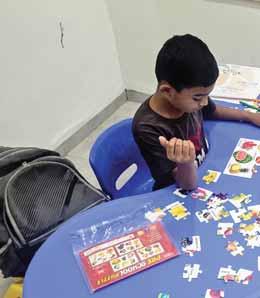
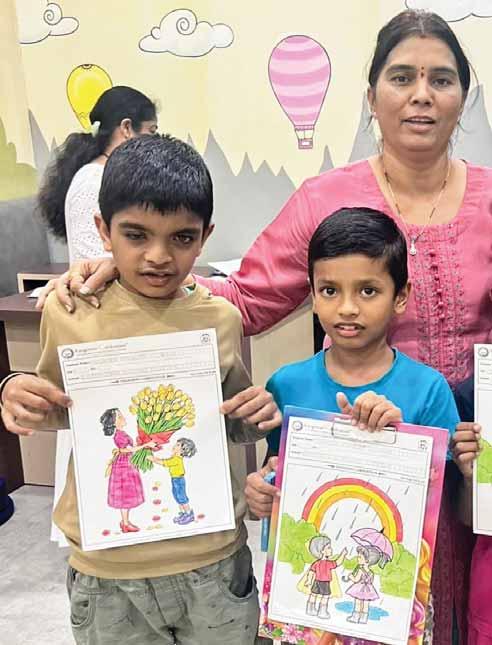
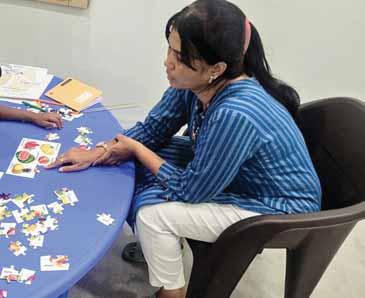
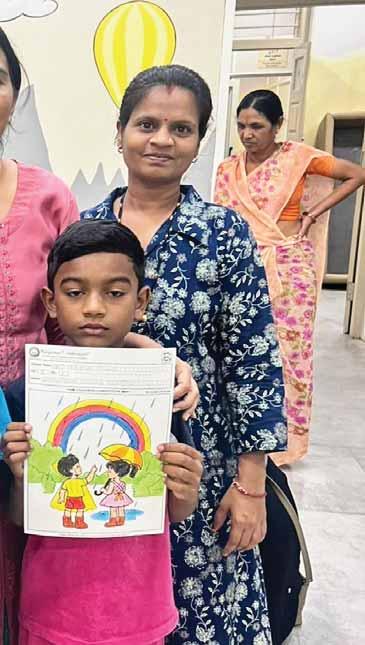
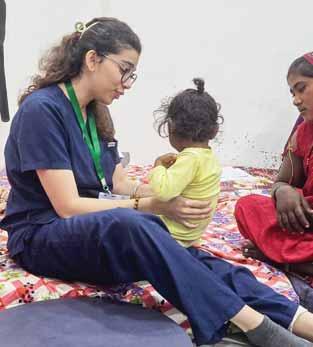
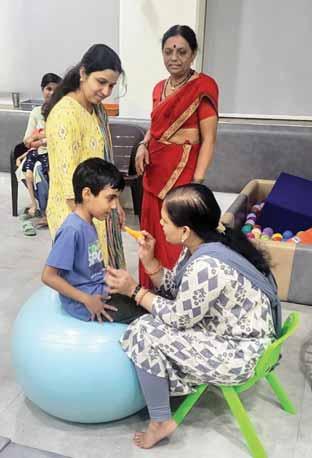
18 years of age diagnosed with autism, neuromuscular conditions, ADHD, and visual and auditory disorders, while also providing counselling for their families.
Rajesh Bhatwal, a past president of RC Dhulia and a former Rotaractor, significantly supports the centre through his corporate Nitiraj Engineers. He remembers how heartbreaking it was to see parents wait six months or more between camps. “That’s when we decided that Dhule needed a permanent centre.” Veeram’s father, Pradeep Shah, also a past president and CSR head at his company, shared the same passion, and “together we made it happen.”
To streamline support, the Rotary Club of Dhule Charitable Trust was formed. Other partners include the Matruseva Sangh, Kamal Udwadia Foundation, where Dr Anaita is a director; State Bank of India and 360 One Asset Management.

The facility is equipped with state-of-the-art devices and therapies: EEG testing to detect abnormalities in the brain, BERA testing to check hearing and nerve function, audiometry testing, and speech and vision
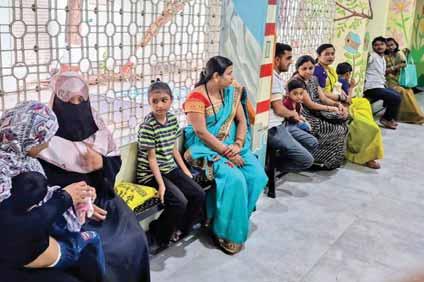
therapy, orthotics and prosthetics are offered. Virtual reality sensory integration session enhances sensory processing, and occupational therapy provides livelihood skills for the older children.
Importantly, services are free for underprivileged families and cost as little as `100 per session for others, compared to `400–500 elsewhere. With 400–500 children visiting every month and 20–25 sessions conducted daily, the centre’s running cost is about `11,000 per day. “Thanks to social media campaigns and 365 committed donors, the centre has never faced a fund crunch,” smiles Veeram.

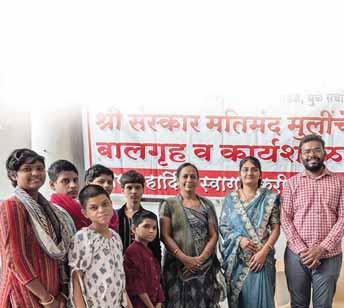

The Rotaract Club of Dhulia, chartered in 1969 and now 50 members strong, also runs Project Aarogya, another impactful initiative. For the past five years, the club has ensured essential medicines and health supplements for 100 girls with mental illness at the Sanskar Matimand School. The monthly expense of `4,000–7,000 has always been sponsored by an individual member or well-wisher, never by the club itself, says club secretary Palash Agarwal.
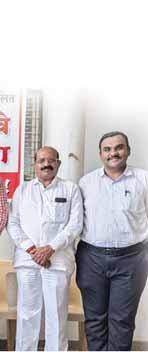

To sustain its other community projects, the club organises a popular mega exhibition every December. During Diwali every year, the Rotaractors launch a sweet distribution drive where they deliver home-made sweets and savouries to NGOs taking care of children and senior citizens. “It is an opportunity for our club members to bond as all of us gather in one of our homes and prepare the goodies ourselves,” he says. Cooked food packets are distributed to street dwellers regularly.

RAC Umbergaon, RID 3060, in collaboration with their parent RC Umbergaon, implemented its Project Shikshan Drashti (Vision for Education) at the Ashram Shala School in Karambele, Umbergaon.
The clubs distributed 70 dozen notebooks (a total of 840 books) to schoolchildren, aiming to help them in their learning journey. The morning began with interaction between Rotaractors, Rotarians and the school community.
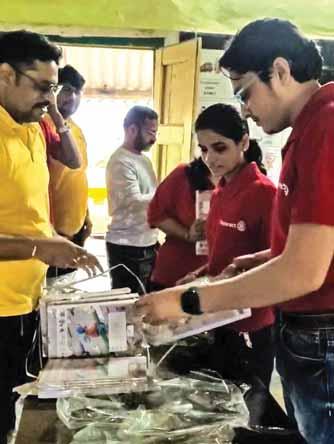

“Excitement filled the classrooms as children received their sets of notebooks, many holding them close with wide smiles,” said Rishi Mehta, the club president.
Teachers expressed their appreciation for the timely support, noting how essential such resources are in rural schools where families often struggle to afford stationery. “This project is close to our heart because access to something as simple as
a notebook can make a big difference in a child’s education,” says Mehta. “We want to ensure that no student feels held back due to lack of resources. The happiness we saw today is a reminder that even small gestures can inspire children to dream bigger.”
One of the teachers remarked that the distribution would help reduce the burden on parents and keep students motivated to attend school regularly.

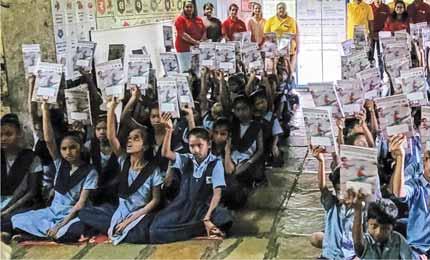
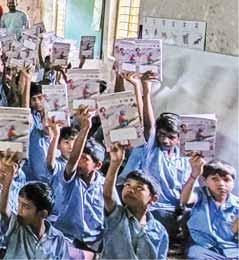
V Muthukumaran
Now Rotaract has opened a new platform for married women in and around Mapusa, a small, scenic town 15km from Panjim, capital city of Goa, to showcase their skills and talent in multiple disciplines with the aim to empower them. “We feel proud and happy about their capabilities,” says Sanjali Navgenkar, immediate past president of RAC Mapusa, RID 3170.
In a novel initiative called Mrs Mhapshekan 2025, referring to married women in Mapusa, around a dozen contestants took part in a series of competitions and talent rounds spread over three months (Jan to Mar 9) that tested their abilities in diverse skills and performances. It was all about live energy and youthful vigour as they sang, danced, acted, recited poetry and much more in the talent rounds to display various forms of stage art, says Sanjali.
The talent rounds were followed by a Q&A session where the contestants had to introduce themselves in a “creative manner, narrate their aspirations and what they want to accomplish in life from a broader perspective.” During the ramp walk, they dressed up in traditional attire of Goa, and performed Fugdi, the traditional folk

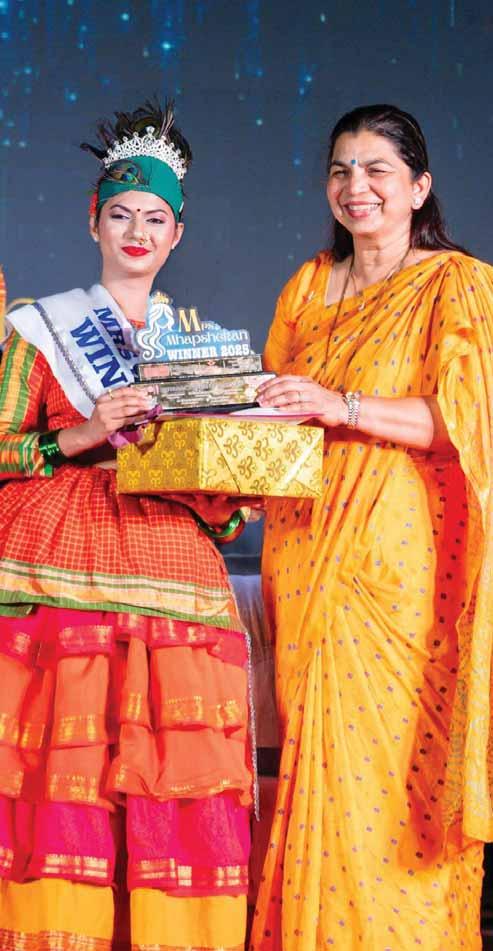

dance of the Konkan region. Special sessions on saree-draping, building self-confidence, and a photo shoot with women clad in same-patterned saree created a buzz at the venue. A martial art exponent taught selfdefence techniques to the participants.
The contestants were given a week-long home assignments such as creating awareness on menstrual hygiene among girls, giving information about government schemes to rural women, holding cooking competition and awareness session on breast cancer, and providing monetary help to SHG women. “We celebrated Women’s Day (Mar 8) with games, song and dance, and cultural shows of our contestants,” says Sanjali.
Sushmita Karpe was crowned Mrs Mhapshekan, followed by two runners-up, Rupali Gaundalkar and Shravani Karapurkar. Pratima Dhond, wife of PDG Gaurish Dhond, Pratiksha Khalap, past president of RC Mapusa Elite, and PDRR Nishita Pednekar were guests of honour at the valedictory event. The first-ever talent show for married women in Goa was curated by Rtr Shreyas Bandodkar, and coordinated by Sohali Nagvenkar.
In the last seven years, 300 children were trained in creating clay
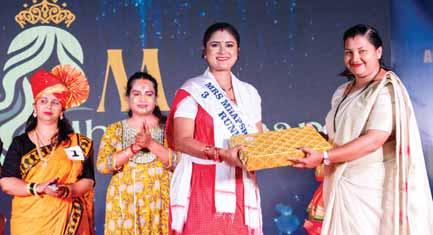
A runner-up contestant being awarded.
Ganesh idols through workshops in the run up to Ganesh Chathurthi. “We teach children how to mould Ganesh idols through clay tablets instead of using Plaster of Paris idols that is harmful to the environment.” This year Rtr Ruchi Parab trained 35 boys and girls in Project Green Ganesha workshop.
Project Yunaay (powerful) saw over 500 people visiting the two-day exhibition and cultural fest leading up to Ganesh Chathurthi. “Around 25 women entrepreneurs displayed their products ranging from food items and furniture to clothing and antique jewellery at the stalls at the Shree Bodgeshwar Hall, Mapusa,” says club president Siddhanshu Salvi.
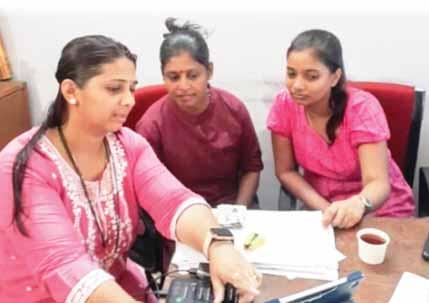
Busy with home assignment.
Diverse competitions such as cooking, Rangoli, Fugdi and ghumat-aarthi ritual were organised for women at the exhibition site, while children got a chance to display their singing and dance skills. During Ganesh Visarjan, Rotaractors placed 12 nirmalya kalash (flower containers) on the route of the idol procession, and “urged the marchers to put the floral waste in the containers instead of throwing it in the water bodies.”
Project Raasleela
During Navratri, a garba-dandiya musical event is organised in a grand manner at the Bodgeshwar Hall with over 2,000 residents of Mapusa gathering at the venue to dance, celebrate and enjoy the spectacle.
“The one-day musical dance with a live band performance is a fundraiser for our Rotaract projects. Last year, we raised around `4 lakh from this garba event, and hope to attract 3,000 people this year with a target of `5 lakh in fundraising,” says Sanjali.
Looking back at her six-year stint in Rotaract, she says, “I have grown up and learnt a number of new things in life, besides gaining new friends.” Employed in a private insurance firm as an executive, she is looking forward to become a Rotarian in two years.

In May, Bill Gates gave himself a bold new challenge and a tough deadline: to give away virtually all his wealth in the next 20 years and close up his long-running philanthropic enterprise. The Gates Foundation, one of Rotary’s partners in the Global Polio Eradication Initiative, has already given away more than $100 billion in its first 25 years. But for the foundation to wind down fully it first needs to ramp up — in order to spend more than twice that amount before it closes its doors on December 31, 2045.
Polio remains a priority. At the 2025 Rotary International Convention in Calgary, Alberta, Rotary and the Gates Foundation announced a joint commitment to direct up to $450 million over the next three years to support polio eradication, a renewal of their long-standing partnership. Rotary will continue to raise $50 million per year, with every dollar matched with two additional dollars from the Gates Foundation.
Diana Schoberg
As he begins to wind down his foundation, Bill Gates makes his biggest plans yet.
bed nets, and diagnostics — has dropped dramatically.
The impact is mind-blowing: Thus far, these collaborations have reached 1.1 billion children with life-saving vaccines, helped cut global child mortality in half, and saved more than 80 million lives. Hundreds of millions of people have risen out of poverty and into better lives.

To learn more about his decision, how he views the foundation’s legacy, and what lies ahead, Rotary posed some questions to Gates, who turns 70 this month. These are the responses he sent in their entirety.
As the Gates Foundation celebrates its 25th anniversary, what are you most proud of?
Over the past 25 years, we’ve witnessed and contributed to more progress than we ever thought possible.

I’m proud of the partnerships that have contributed to saving lives — not only the Global Polio Eradication Initiative but also the Global Fund to Fight AIDS, Tuberculosis and Malaria, and Gavi, the Vaccine Alliance. Thanks to these programmes, the price of life-saving healthcare innovations — vaccines, treatments,

As you wind down your foundation over the next 20 years, where do you think your money will make the biggest impact? What headwinds do you anticipate?
In spite of all of the progress I’ve just described, we are seeing the toughest headwinds in the history of our foundation. Countries are slashing tens of billions of dollars in global development
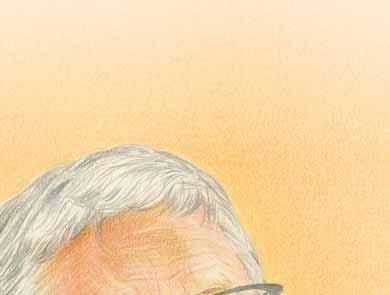
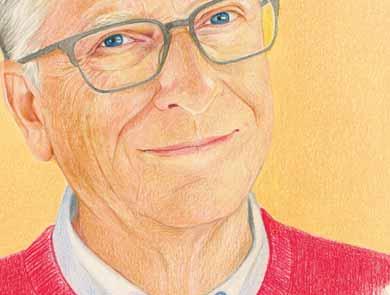
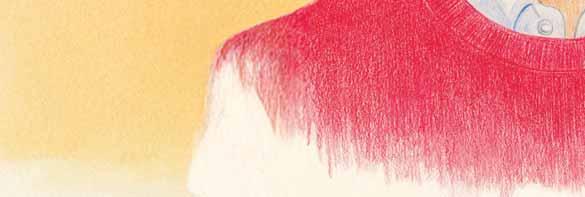
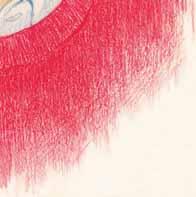

funding, and the consequences will be deadly. In fact, this will be the first year in the new millennium when the number of kids dying around the world goes up instead of down — an unthinkable tragedy.
We need people who are committed to progress — like Rotarians — to stand against these deadly cuts and help us get back on a path to progress.
For our part, we will be accelerating our work over the next 20 years to solve urgent problems and save and improve more lives. We remain steadfastly focused on where we can have the most impact: reducing child mortality, eradicating or eliminating infectious diseases, and lifting millions more people out of poverty and onto a path to prosperity.
We’re placing our bet on human ingenuity — on the scientists, health workers, educators, and farmers whose tireless work has already delivered some of the most dramatic gains in human history. They haven’t given up, and neither will we.
How do you ensure sustainability?
What makes you optimistic polio eradication is still possible?
I am as confident as ever that the global polio programme will end polio for good.
What keeps me optimistic, despite some challenges, are the innovation, frontline workers, and global commitment driving this effort forward. The next-generation polio vaccine, nOPV2, is helping to stop outbreaks, protecting children in under-immunised communities from paralysis.More than 1.6 billion doses have been administered as of July 2025 — that is an incredible number of children protected from this devastating disease. And we now have enough supply of this new vaccine to protect children wherever it emerges.


Our goal at the Gates Foundation has always been to solve problems, not manage them in perpetuity. That means helping communities build capacity to take on the challenges they face. That will be our priority for the next 20 years, and we hope it will be the priority for the next generation of catalytic philanthropists who will take up the challenges of their time.
New innovations will continue to give these communities better tools than ever before to invest in their own health and prosperity. So, despite the challenges we face,
In the countries where wild polio remains endemic, Afghanistan and Pakistan, the programme is working closely with local authorities to tackle obstacles, improving cross-border coordination and strengthening community trust to reach all children with vaccines.

I’m optimistic. The past 25 years was one of the greatest periods of human progress in history, and I believe that we can make the next 20 years even more transformative.
Wild poliovirus case counts rose in 2024.
Help Rotary and its partners reach every child with the polio vaccine. Thanks to the Gates Foundation, your contribution will be tripled. Make your donation at my.rotary.org/polioplus-fund .

Despite the recent uptick in cases, we shouldn’t lose sight of the broader progress, which really is remarkable: the Global Polio Eradication Initiative has eliminated wild poliovirus in almost every country in the world, reducing the number of polio cases by over 99 per cent.With continued commitment and collaboration, including from Rotarians around the globe, I am confident we can finish the job.
How is the polio programme pivoting given the current political and economic volatility? Is there any change to how your foundation is doing its work toward ending polio?
Take Pakistan as an example. Security forces sometimes provide support in conflict areas so that vaccinators can do their jobs safely. But in areas of the Khyber Pakhtunkhwa province where conflict has been on the rise, the presence of those security forces was actually keeping families from feeling safe enough to go get vaccinated. So local influencers stepped in to keep vaccinators safe without having to involve security forces at all. The approach has been working well, with a reported 80 per cent of children being reached. It will be critical that the programme independently monitor these areas so we can be confident in the results.

The polio programme has a long history of adapting to stop polio in some of the world’s most complex settings — working closely with governments and communities to protect routine immunisation progress and stay focused on eradication.

Today, amid competing health priorities and growing political and financial pressures, we know tough challenges lie ahead. Some major donors are reducing support for global health, but new donors are also coming in with contributions, which is so critical at this time. And we are continuing to adapt as we do best, staying laser-focused on what works and using financial and human resources where they will have the greatest impact to end polio for good.
What’s the biggest lesson you’ve learned in your time working on polio eradication?
Progress depends on relentless collaboration. Success is only possible

when polio workers, government officials, partners and donors — including Rotary — all work together to reach children with life-saving vaccines, even in the world’s hardest-toaccess areas.
We observed the power of this kind of collaboration recently in Madagascar during an outbreak of variant poliovirus. The government came in with strong political leadership to halt the spread; community partners worked quickly to strengthen vaccination campaigns; and international partners like UNICEF and the World Health Organisation surged support to bolster those efforts. Everyone worked to protect children with vaccines in some of the most distant and isolated regions of the country, and they succeeded in stopping the outbreak.
Ending polio for good will require more collaboration like this whenever and wherever the disease continues to emerge. Rotary members’ roles as global advocates and civic leaders are critical to ensure polio eradication remains a top global priority.
The Gates Foundation has funded technical innovations in polio vaccines for two decades, including the development and rollout
Gates Foundation
To Rotarians everywhere:
Thank you for decades of dedication and partnership. Because of your efforts, we will one day live in a world where all children are safe from this disease.

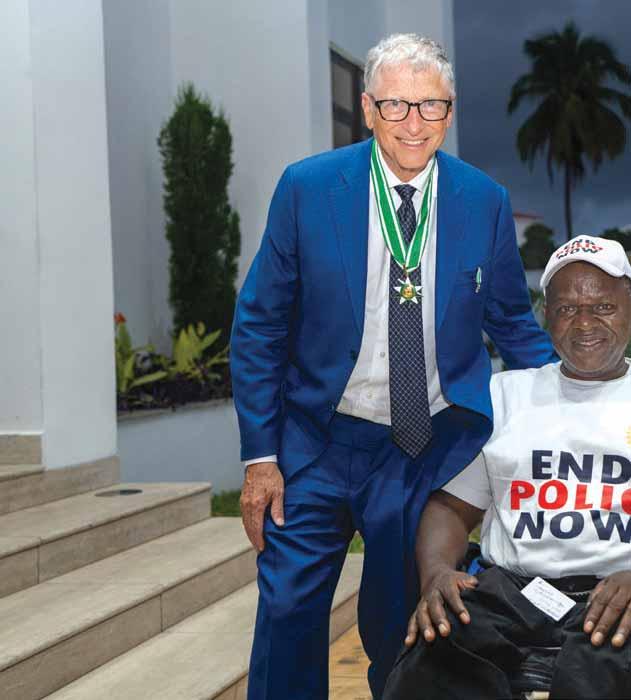
of nOPV2. What most excites you about what’s in the research and development pipeline now?
Sustained investment in innovation is as critical as ever. As I mentioned, nOPV2 is already helping close outbreaks, and we continue to invest in more genetically stable vaccines to keep future generations safe from variant polioviruses. These advances are helping us stop transmission faster and protect more children with greater precision.
We’re also excited about the hexavalent vaccine, which combines protection for children into a single shot against six diseases: diphtheria, pertussis, tetanus, Haemophilus influenzae type B, and hepatitis B, along with polio. This simplifies immunisation schedules and strengthens early protection for
children, especially in regions that have limited health care resources. In fact, in July, Senegal (W Africa) and Mauritania (N W Africa) became the first countries to introduce this vaccine with support from Gavi, the Vaccine Alliance.
These innovative vaccines are giving frontline healthcare workers better tools to reach every child and stop transmission of all forms of polio for good.
Why did you choose to have the Gates Foundation partner with Rotary? What does Rotary bring to the table?
Rotary was the first organisation to envision a world without polio, and members’ leadership has been essential in driving this global effort for over four decades.
In June, Bill Gates dedicated an award he received from the Nigerian president to Chief Ayuba Gufwan. Paralysed by polio at age 5, Gufwan serves as the executive secretary of Nigeria’s National Commission for Persons with Disabilities and CEO of Wheelchairs for Nigeria.

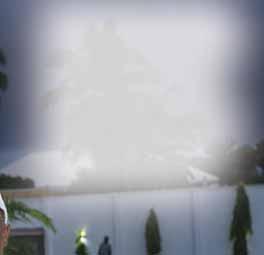
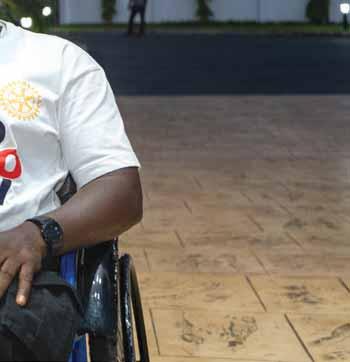
As a founding partner of the GPEI, Rotary has helped vaccinate nearly three billion children across hundreds of countries since 1985. Rotary members have contributed numerous volunteer hours and significant funding, and their advocacy has helped secure billions more from governments to support eradication efforts. Their global network allows them to deliver vaccines and engage communities in the toughest settings, from India to the Philippines to Ukraine.
Because of Rotary’s leadership, we are closer than ever to our shared goal of ensuring that families will never have to fear this disease again.
Why are you extending the Gates Foundation’s 2-to-1 funding match with Rotary?
Together, we hope to mobilise up to $450 million in new funding over the next three years. These funds will be used to support vaccine delivery, outbreak response, community engagement, and implementation and maintenance of polio eradication programmes in affected regions.
This extension comes at a critical time. Over the past year, we have seen wild polio case numbers rise in the last endemic countries, Afghanistan and Pakistan. And the detection of polio in places that were previously polio-free is a stark reminder that polio anywhere is a threat to people everywhere.While transmission overall remains low, our hard-won progress is at risk. Reductions in global aid, vaccine misinformation, and rising conflict and political instability are all contributing to polio’s continued spread.
Continuing our partnership with Rotary will allow us to address these challenges and reach children around the world with life-saving vaccines. It is critical that we finish the job on polio. Eradication is the only way to make sure that continuing challenges don’t mean an ongoing risk for children today and for generations to come.
In 2009, your father, Bill Gates Sr, suggested to Seattle Rotarians that they work on malaria eradication. Over the years, their work has grown into the Rotary Healthy Communities Challenge, which the Gates Foundation supports through a $13 million donation and technical assistance and guidance. How does this project fit into your overall strategy for malaria eradication and preventing childhood deaths?
Our long-standing partnership with Rotarians has been critical to the progress we’ve seen against malaria in recent decades — and it’s more important today than ever, in the face of shifting agendas and uncertain financing that are putting this progress at risk.
Over the past 25 years, 2.2 billion cases of malaria and 12.7 million deaths have been averted — thanks to innovation, generous aid, and political commitment. For the first time, eradication is within our view, and the pipeline of next-generation tools to bring that vision to reality has never been stronger.
Rotary’s work is essential to building the networks of community health workers who will bring these tools to the people who need them. Through the Healthy Communities Challenge, Rotary is helping to train thousands of community health workers across the Democratic Republic of Congo, Mozambique, Nigeria and Zambia who are treating malaria, pneumonia, and diarrhoea in their own communities. These community health workers know their communities in ways no one else could. They’re the ones who will get us across the finish line in beating malaria in the toughest places — and in the process, they’ll build the foundation for healthier, more resilient communities that can face multiple health challenges.
How will AI impact development?
Paint us a picture of what healthcare, agriculture, education etc might look like in 20 years. Artificial intelligence has the potential to help solve some of the world’s toughest challenges. One of the key ways AI is helping to shape the future is by providing critical support to frontline workers — including community health workers, farmers, and teachers — who are using AI to reach people more efficiently and effectively.
In global health, AI-powered tools could significantly reduce pressure on overburdened healthcare systems by supporting frontline workers in diagnosing health problems and delivering better, more effective care. Imagine a nurse in a rural clinic using an AI tool to analyse a patient’s symptoms, flag high-risk cases, and provide accurate
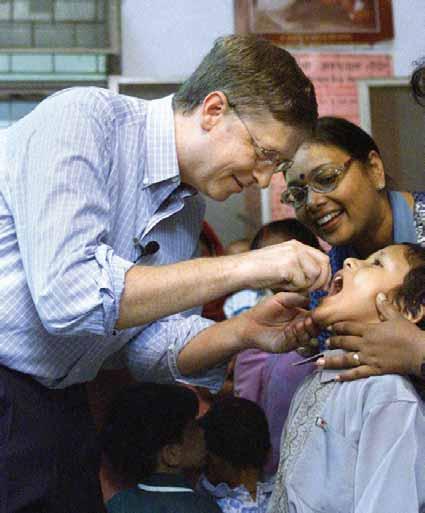
September 2000 photo captures Gates giving the polio vaccine to a child in India, an illustration of his long-standing commitment to ending the disease.
diagnoses and treatment suggestions. This kind of real-time clinical support could improve both accuracy and access, bridging long-standing gaps in care and bringing life-saving capabilities to those who need them most.
Our long-standing partnership with Rotarians has been critical to the progress we’ve seen against malaria in recent decades.
And this is just the beginning. In agriculture, AI is delivering tailored advice to smallholder farmers to increase agricultural production. In classrooms, AI-powered tools are helping teachers personalise lessons for students and improve learning outcomes.
If the world continues to prioritise equity and access at the forefront, AI can be a powerful force multiplier for development — expanding opportunity, reducing inequality, and improving millions of lives.
Rotary has been increasingly emphasising measurable impact in its projects. As someone who has long been focused on data collection, can you give our members any advice?
Quality, timely data is critical for everything from development of AI-backed tools to vaccine delivery to advocacy. Through advances in how researchers collect and analyse global health data, we now know much more about what kills children, where these deaths occur, and why some kids are more vulnerable than others. By putting those insights to work, we’ve been able to make incredible progress over the last 25 years, reducing child mortality and saving lives. Over time, better data has revolutionised how we understand health challenges, target resources, and measure impact — and remains one of the most powerful tools we have to drive future progress.
Investing in data is a smart, costeffective way to create impact. Continuing to improve data-gathering and to invest in the collection of quality data will give us a fuller picture of where our investments and programmes will have the greatest impact and help us build solutions to some of the world’s toughest health challenges. Measuring impact and starting with quality data to design programmes will make Rotary initiatives even more effective.
What message do you have for Rotary members?
Most importantly, thank you for your unwavering support to eradicating polio. Rotary’s leadership, advocacy, and sustained commitment have brought the world to the brink of eradication — something once thought to be impossible.
To Rotarians everywhere: Thank you for decades of dedication and partnership. Because of your efforts, we will one day live in a world where all children are safe from this disease. We look forward to leaving polio behind long before our foundation closes its doors in 2045.
Reproduced from Rotary
Olayinka Hakeem Babalola, a member of the Rotary Club of Trans Amadi, RID 9141, Nigeria, has been selected by the Board of Directors to become RI President for 2026–27. His term will begin on July 1, 2026.
The Board, guided by the RI code of policies, conducted a special session to select the organisation’s leader after the resignation of RI President-elect SangKoo Yun, who decided to step back from his Rotary responsibilities and focus on his recovery from recent cancer treatment.
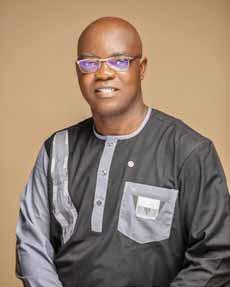
Babalola began his Rotary journey in 1984 as a Rotaractor. He joined his club 10 years later. His leadership roles include serving as DG (2011–12), RI vice-president (2019–20), and member of the RI Board (2018–20). He was also an active leader and participant in RI committees such as the End Polio Now Countdown to History Campaign Committee (2017–23) and the Nigeria National
PolioPlus Committee (2013-present, adviser 2016-present).
Babalola received a university degree in engineering in 1988. He worked for 25 years in the oil and gas industry, holding senior positions in Shell PLC. He is the founder of two companies: Riviera Technical Services Ltd, an oil and gas infrastructure delivery company, and Lead and Change Consulting, an executive coaching and organisational performance advisory group.
Babalola and his wife, Preba, live in the city of Port Harcourt. He supports TRF with a named endowment and as an Arch Klumph Society member. A trustee of ShelterBox UK, he is a recipient of the Africa Centennial Heroes Award, the Regional Service Award for a Polio-Free World, the RI Service Above Self Award, and The Rotary Foundation Citation for Meritorious Service.
Rotary.org
Congratulations to the 1,036 Rotaract clubs worldwide that earned the 2024–25 Rotaract Giving Certificate! Of these, 78 clubs are from the South Asia region.
This recognition celebrates clubs whose members contributed $100 or more to The Rotary Foundation during the Rotary year. Each club will receive a certificate
signed by 2024–25 Foundation Trustee Chair Mark Maloney. Rotaract clubs contributed $506,696 to the Foundation in RY 2024–25, marking an increase of 29.4 per cent from 2023–24 total of $391,558, reflecting the growing impact and dedication of Rotaractors. Last year 882 Rotaract clubs had earned the Rotaract Giving Certificate.
Rotaract clubs who have earned the Rotaract Giving Certificate over the past five years have contributed more than $1.3 million to TRF, thus helping make global grants possible and funding meaningful, sustainable projects.
Refer A record-breaking year for Rotaract giving | My Rotary for the clubs that have earned the certificate.
RISAO
V Muthukumaran
All roads in Gujarat led to Patan, a small historical town 125km to the northwest of Ahmedabad, as this ancient place is quite popular for hosting a 10-day Garba Dandiya festival in Sep-Oct Navratri times. The Garba nights with dandiya dance is organised by RAC Patan, RID 3055, and attracts more than a lakh people from across the state.
In fact, most of the Rotarians and Rotaractors from RID 3055 look forward to participate in this mega Navratri musical nights being staged on Panjarapol ground — a place for rehabilitation of stray cattle — which is decked up with festival shamiana (a huge canopy) and other colourful banners, flyers and buntings under floodlights,” explains Chetan Prajapati, a dual member and club advisor of RAC Patan.
As a ticketed event, Project Rankaar is a 32-year-old major fundraiser for the Rotaract club and “we collect a sizeable amount each year for our service projects and other community initiatives,” he says. The 10th night is celebrated as Dussehra to mark “the victory of Lord Ram over demon king Ravan that symbolised the eternal triumph of good over evil in this world,” he smiles.
Five years ago, each Navratri celebration in Patan had a new title given by the Rotaractors, “but from 2020, we got to call it by the same name, Rankaar which means ‘the echo of a particular musical beat’. The club has set a fundraising target of `11 lakh from the Garba nights this
year as compared to `8 lakh collected last year (2024–25).
The 36-year-old Rotaract club has another iconic project called Shaurya Sandhya (heroic evening) with a tagline Ek Shaam Shahid ke Naam, which means ‘one evening in the name of soldiers’. They honour the families of soldiers, who had laid down their lives guarding our frontiers, with cash prizes and mementos in a grand awards ceremony, says Prajapati. Patriotic skits, dance performances, songs and recounting the battlefield events of deceased soldiers “create a sense of bonding with the bravehearts’ families as some of their valorous sacrifices

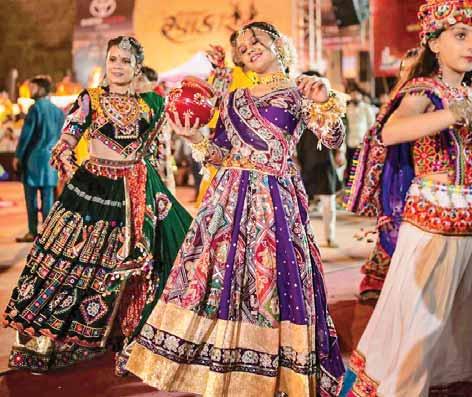

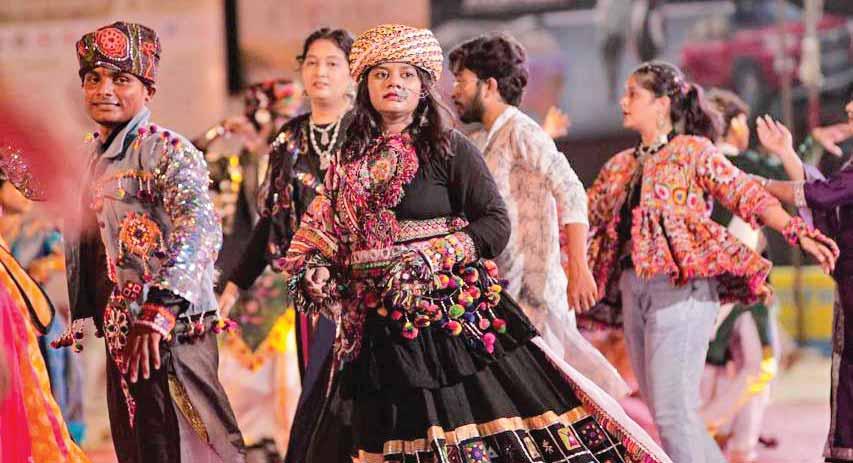
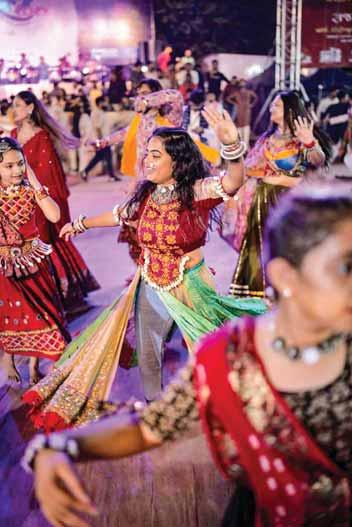
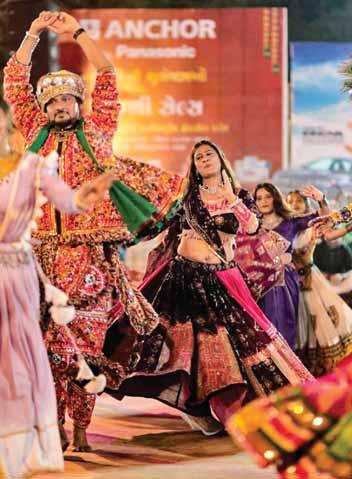
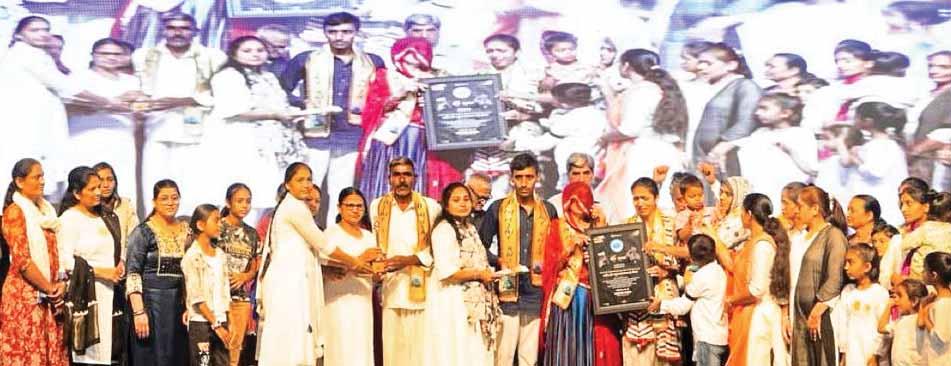
are being narrated for the first time to the public,” he explains. Over the last nine six years, the club honoured 80 families of soldiers killed in action with cash prizes and mementos at the awards ceremony, being held every two years. “Some of them were
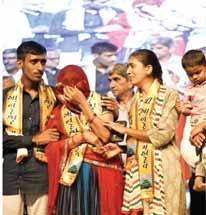
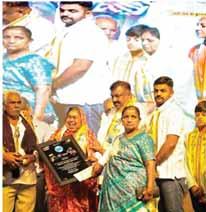
felicitated at their homes as they don’t want their sons’ (or husbands) heroic deed to be publicised.”
Consisting of over 100 Rotaractors, around 90 per cent of them are college students, and the rest are working professionals and small
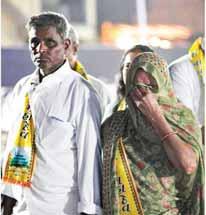
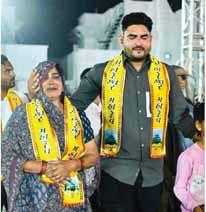
entrepreneurs, “our parent Rotarians (from RC Patan) extend their moral and monetary support to our service initiatives,” says club president Jayesh Shivamkumar Patel. “We are always ready to carry out our service projects that add value to the society in and around Patan.”
One constant feature of their service outreach is the holding of blood donation camps throughout the year in Patan and nearby villages. “We hold the blood donation drive at different places with the support of local hospitals, and collect hundreds of units each year,” says Prajapati. A mega blood donation camp during Operation Sindoor collected around 350 bottles of blood and “this event boost the public image of Rotaractors.”
Working as an assistant professor at the Government Arts and Commerce College, Sami, a taluk in Patan district, Chetan Prajapati has been a Rotaractor for 15 years and a member of RC Patan for five years. On his Rotary-Rotaract coordination work, he says, “this job has been a tremendous boost for me, adding so many values of social responsibility in my life.” As most of the Rotaractors are his former students, “who have learnt under me, they respect me and are ready to share social responsibility for the good of the community,” he smiles.
Jaishree
For 50–60 children across seven slum localities of Delhi, weekends now mean more than just playtime — they mean discovering a world of knowledge, creativity and care, thanks to the Rotaract Club of College of Vocational Studies, RID 3011.
Under Project Gyansetu, which aptly translates to a bridge of knowledge, the Rotaractors have become that bridge of love and endless possibilities. “We gather the children in an open space, teach them basic English, functional Maths, and lessons in hygiene, nutrition, values and manners,” says club secretary Karthik Kumar.
But the sessions aren’t all about studies. Games, painting and craft activities are woven in, making the
weekends something the children eagerly look forward to. “In fact, no child wants to miss the classes,” smiles Kumar, recalling how one boy, also named Karthik, can now converse fluently in English.
Alongside learning, the children receive notebooks, pens and colouring sets. With the support of philanthropists, freshly-packed food is also distributed regularly. “Most of these children are alone at home while their parents are away at work. These sessions give them direction and a safe space,” says club president Divya Verma.
Though the club had experimented with Gyansetu earlier, this Rotary year marks a new commitment — planned, regular weekend classes, complete
with debates and oratorical contests to build confidence in the young learners. The club’s efforts don’t stop there. Partnering with Interactors and NGOs, the Rotaractors have planted nearly 4,000 saplings across the city, ensuring their survival with guards and care. Through Project Naaritva , they’ve organised menstrual health awareness sessions and distributed sanitary napkins to women and adolescent girls in Delhi slums. Plans are underway to provide skill-based training to help women earn sustainable incoms.
Chartered in 2018 by the Rotary Club of Delhi South West, the RAC College of Vocational Studies has made its mark with impactful initiatives, from tree planting and river rejuvenation to grassroots education.
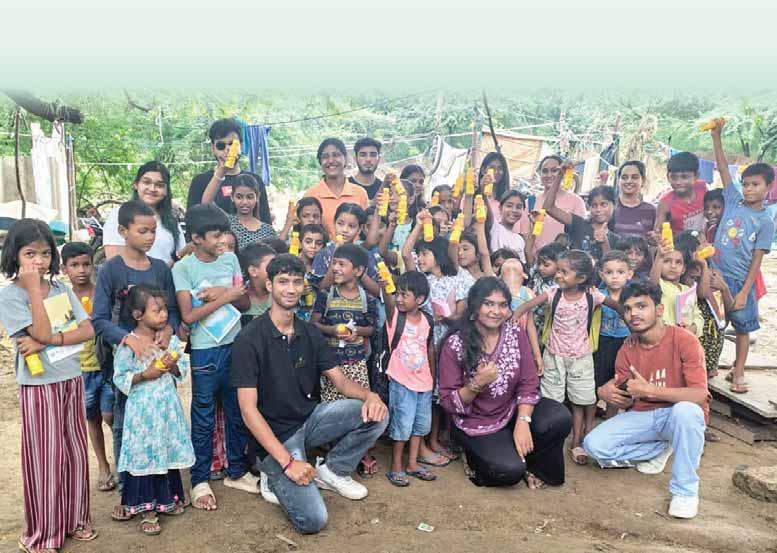
V Muthukumaran
Over 8,500 food packets, 250 Rotaractors, 28 Rotaract clubs, 6 countries, 4 years… this is the snapshot of Project Aravind , conceived in memory of Rtr Muthu Bharathi’s elder brother late Muthu Aravind who died within eight months of his birth in 1999 as he was a blue baby with multiples holes in the heart.
After winning several Rotaract awards including the SEARIC Special Recognition honour for the impactful food distribution drive across six countries —India, Brazil, Uganda, Nigeria, Sri Lanka and Pakistan — Bharathi looks back at the four-year-old project journey that began when he was president of RAC AM Jain College, Shift-I,
RID 3234. Later on when he was charter president of RAC Chennai Genesis in 2023–24, “we began to expand our food distribution drive reaching out to homeless, deprived families across Tamil Nadu, and making our presence felt in Bengaluru, Andhra Pradesh and Mumbai,” says Bharathi.
To mark the charter year of RID 3234,
Rotaract teams distributed 3,234 food packets all over Indian cities and towns, “with loads of encouragement from the then DG NS Saravanan and DRR Sasi Kumar” and completed the project in less than a month.
No publicity please One of the hallmarks of Project Aravind is that Rotaractors don’t take photos, shoot videos or
RID 3234 IPDRR Sasi Kumar (centre) and RAC Chennai Genesis charter president Muthu Bharathi (right) receive the SEARIC Special Recognition Award 2024–25 for Project Aravind from the then SEARIC-MDIO president Abhijith MS (3rd from left) and
Aravind from the then SEARICMDIO president M S (3 from and other r office-bbearers
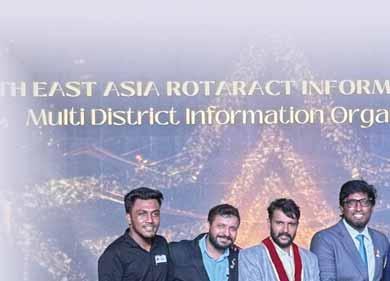
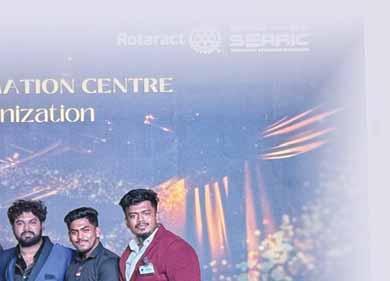
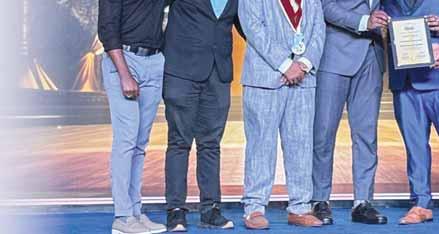
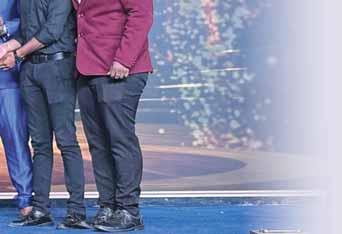
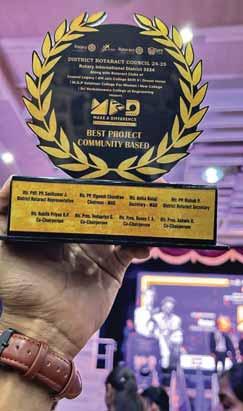
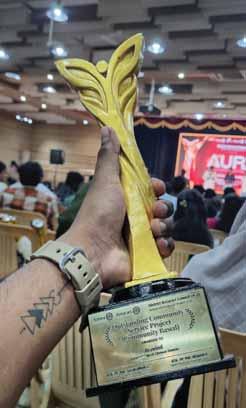
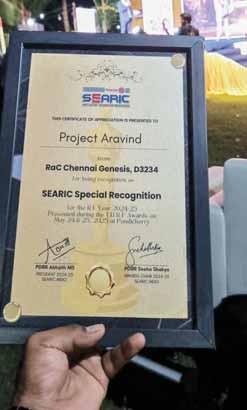
Project Aravind got one SEARIC Award and two Rotaract District Council Awards for its impact across communities.
launch a social media campaign “to spread the word around.” Apart from helping the poor by giving them food, “we want Rotaractors to experience the joy of giving, and feel the happiness in donating food to needy families,” explains Bharathi. Moreover, they don’t collect money from donors or sponsors, “every Rotaractor buys freshly cooked food, neatly packed from hotel chains, eateries and restaurants by spending out of their pockets.”
Usually, all the Indian and foreign clubs finish the project in a month or so, but this year “we will be conducting the food
distribution drive for six month. Our basic aim is to make donation a habit among Rotaractors of the world. Once the joy of giving is embedded on our psyche, we will become an addict to it, and giving will become a life-long habit,” reasons Bharathi.
Another noble initiative is the two-year-old Project Power of Youth, under which Rotaractors deliver daily essentials like milk, foods like bread, biscuits, and medicines to flood victims in Chennai during monsoon season. “People in low-lying areas on the suburbs have to vacate the houses, and move to government-run camps or safer places when floods
inundate their localities. In such times, we visit those areas, and so far we have reached out to 500 families hit by flood fury,” says Bharathi.
With 23 members in all, the two-year-old RAC Chennai Genesis has a mix of diverse professionals including IT techies, entrepreneurs, freelancers and lawyers.
Looking back at his six-year journey as Rotaractor, Bharathi enjoys being a dual member of both Rotaract and Rotary clubs. When he was charter president of his Rotaract club, he was also president of the Rotary E-Club of Chennai Prisms, the earlier version of RC Chennai Sea View,
which, along with RC Chennai Thiruvanmiyur, sponsors the Genesis Rotaract.
As a freelance poster designer for commercials and private clubs, he runs a studio, and aspires to become a DRR to guide RID 3234 in the near future. “Rotary and Rotaract have deeply ingrained in my lifecycle. If I become a DRR, then I will make RID 3234 the largest Rotaract district in the world,” he says and cited the then RID 3232 (Chennai zone before it was bifurcated into RIDs 3234 and 3233) had the largest number of Rotaractors till recently. Bharathi is a Paul Harris, Stage-4, Fellow.
Kiran Zehra
It is normal to feel exhausted or anxious after childbirth. What matters is knowing when to ask for help,” a Rotaractor explained to a group of women in a Patna slum. Some mothers leaned forward with questions about sleepless nights and constant worry, while others simply listened, hearing, for the first time, that postpartum depression was not weakness but a health issue that could be managed. This interaction was one of many activities carried out under Project Sneh (love), Rotaract District 3120’s
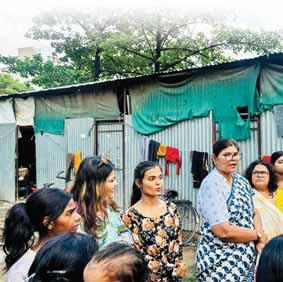

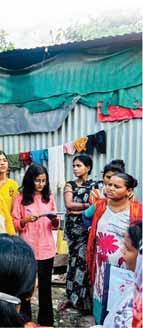
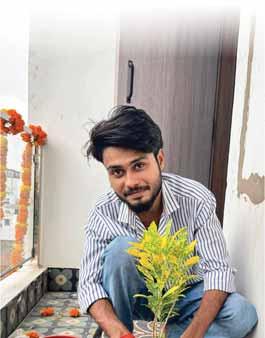
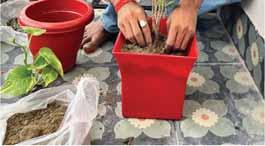
official July month project focusing on maternal and child health. Over the course of a month, Rotaractors across the district organised pregnancy yoga sessions, rural birth planning workshops, vaccination and breastfeeding awareness campaigns, distribution of baby kits and eco-friendly diapers, postpartum mental health camps, and even ‘fatherhood babysitting’ training.
The project recognised that maternal care extends beyond medical support. Postpartum camps guided mothers in recognising signs of depression, learning relaxation techniques, and sharing experiences with peers. The initiative also broke stereotypes by placing families, not just mothers, at the centre of maternal care. Postpartum camps taught women to identify signs of depression and use simple stress management techniques, while also encouraging
them to seek help when needed. Fatherhood babysitting sessions nudged men to participate in newborn care, challenging cultural norms but slowly shifting attitudes.
By including eco-friendly solutions like cloth diapers, Rotaractors added a sustainability angle to maternal health. “By introducing innovations like eco-friendly diapers and familyinclusive health education, Sneh combined compassion with fresh ideas — showing that small behavioural shifts can create lasting change in family wellbeing,” says project coordinator Muskan Singh.
Instead of handing over a bouquet, a Rotaractor offered a small tulsi plant at a community event in Allahabad. “The gesture surprised the recipient but also delighted him. This gift would keep growing long after the moment had passed. Such simple acts of replacing a bouquet with a plant sapling are at the heart of Project Prakruthu Bandhan, a campaign that replaced wasteful customs with green ones,” says DRR Mahi Bhan. He adds that the project “gave
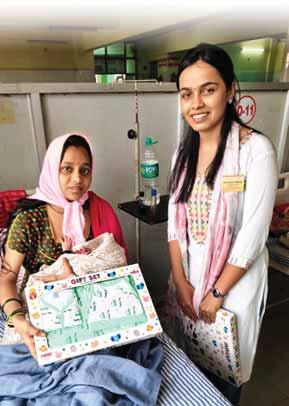
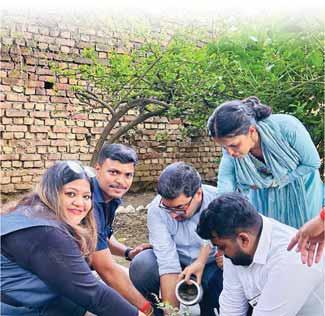
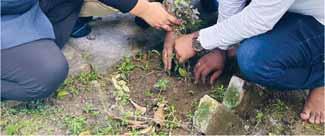
Rotaractors simple but powerful tools such as planting, gifting seeds and saplings, and creating awareness on environmentalism from an abstract cause into a daily practice.”
Across the district Rotaractors translated this idea into three campaigns: Green Gifting, Roots in Schools and One Home, One Plant. “From classrooms where children tended herbal gardens, to homes where families proudly watered their tulsi and neem saplings, the campaign touched thousands of lives and spaces,” says district chair Kushagra Mishra.
The project also created a patriotic fervour with Vriksh Veer (Tree Soldiers). Each sapling planted was dedicated to a Kargil hero, “turning the tree plantating drive into a living tribute. Rotaractors across the district planted saplings in homes, schools, parks, and villages, each one carrying the memory of a fallen soldier,” says Bhan.
Atransparent booth made of quality stainless steel and glass panels was inaugurated at a busy junction of Ambajogai (Maharashtra) with the aim to ensure traffic management and the safety of motorists.
Set up by RAC Ambajogai City, RID 3132, at a cost of `90,000, contributed entirely by Rotactors, the police booth is furnished with a ceiling fan and internal lighting, along with an efficient sound system for public announcements.
The traffic booth was inaugurated in the presence of police officers, civic officials and community members.
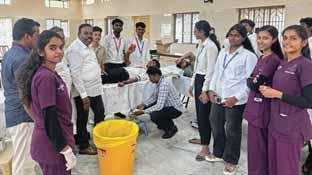
Rotaractors and volunteers at the blood donation camp.
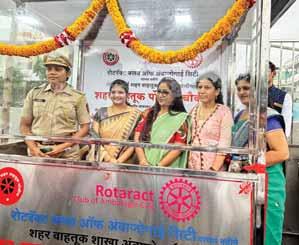
Over100 volunteers came forward to donate blood at a mega blood donation camp organised by RAC Sri Ramakrishna College of Arts and Science, RID 3206, on their college campus. It was preceded by health screening by a medical team to ensure the safety of donors, all of whom got certificates of appreciation and refreshment.
Apart from raising awareness on blood donation, the camp supported the local blood banks by collecting over 100 units which will save countless lives.
The blood donation drive brought together Rotaractors, students and medical professionals with a single purpose of saving lives. DRR Gogul R, PDRR Thanghapantieyaan and other district Rotaract leaders were present.
Under Project Spreading Smiles with a tagline ‘One Book at a Time,’ members of RAC Kharach Kosamba, RID 3060, distributed over 340 books to a government primary school, thus benefitting 55 students. Rotaractors wished each child a year filled with “deep learning, curiosity and success.” For, children deserve the right tools to chase their dreams, and it all starts with a book.
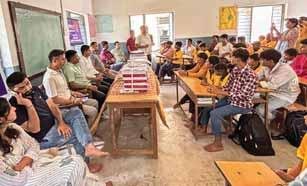
Rotaractors engage students before distributing books to them.
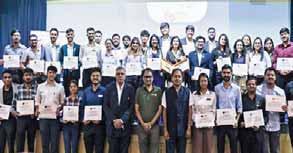
Rotaract club presidents hold India Book of Records certificates along with the then DRR Drishti Singh and dignitaries.
OnWorld Rotaract Day (March 13), a total of 1,753 people across India took an online pledge to donate their eyes and raise awareness about eye donation in a virtual event hosted by Rotaractors of RID 3131 under their flagship Project Drishti. Thus, RID 3131 set a new India Book of Records for the ‘Maximum people taking online pledge for eye donation in a day.’
This project spreads awareness on eye donation and contributes to the fight against preventable blindness in the country. Then DRR Drishti Singh and project chairperson Karishma Awari coordinated the online event in tie-up with the HV Desai Eye Hospital and Mohan Foundation, their NGO partner.
The campaign continued throughout the Rotaract Week, ensuring that more people were motivated to pledge their eyes, and the total count of future eye donors crossed 2,000 during the week.
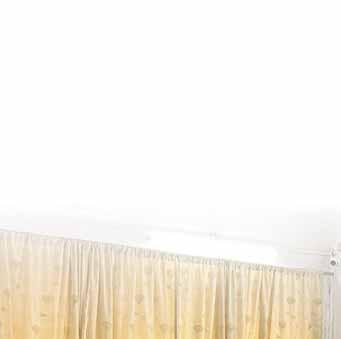
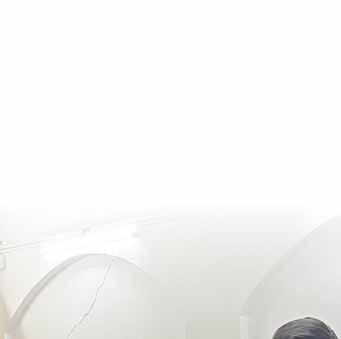
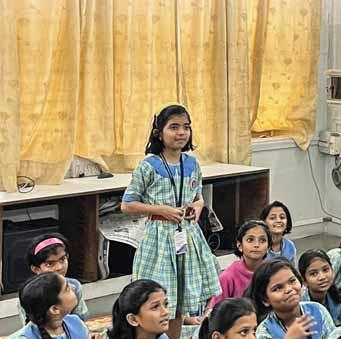
A good touch, bad touch session in progress.
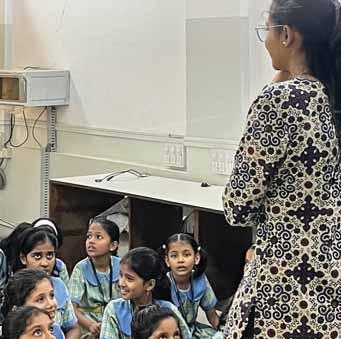
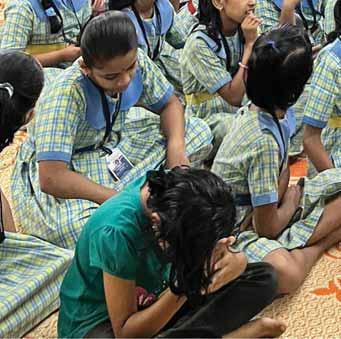
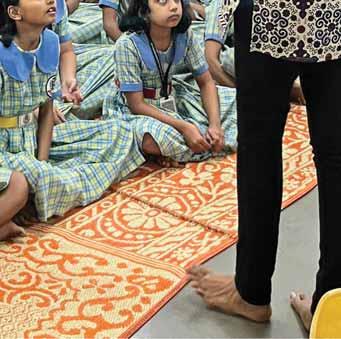
Creating awareness on menstrual hygiene among young girls and women under Project Nirbhaya is on the priority list of RAC Kolhapur Central, RID 3170, a three-yearold community-based club with 25 Rotaractors drawn from diverse professions.
Giving an insight into this MHM (menstrual hygiene management) project, a two-year-old initiative, club president Ashutosh Parab says, “we have reached out to 1,150 girls studying in Class 5–9 at eight rural middle schools, both at the panchayat and zilla parishad-level through awareness sessions conducted by our team of 10 Rotaractors, who are also doctors.” Each MHM session lasts not more than two hours in which lectures, tips and suggestions are given on best hygiene practices during menstruation. So far, around 1,250 sanitary pads were distributed.
Sponsored by their parent Rotary, RC Kolhapur Central, and private donors who support their cause, the project will be conducted at 5–6 schools this year, “besides a few sanitary pad disposal machines will be installed,” says Parab.
A two-day football tournament titled Futsal was organised with the participation of 32 professional and amateur teams, “that will boost our public image in and around Kolhapur.”
Following the open tournament for the public, another zonal-level Rotaract football meet was held for Rotaractors from RID 3170 in which a few teams from other RI dsitricts too contested. “The Rotaract football fixture created a new sense of bonhomie among district Rotaactors as the sports event gave us the right moments for bonding and striking new friendships.”
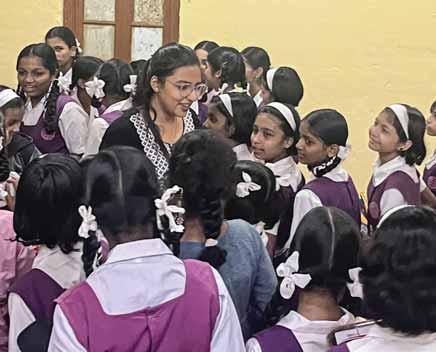
On the last day of the weeklong Ganesh Chathurthi festival, an elaborate aarthi ritual-cum-pooja was held at the homes of 12 Rotaactors wherein around “20 of us were present, and we all got soaked in spiritual vibes at our friends’ houses, thus strengthening our bonds.”
Under Project One Club One School initiated by IPDRR Nikhil Chindak (2024–25), the club distributed 250 school bags and stationary items to students at three zilla parishad and rural schools last year. “Now we are going to adopt a Government Middle School, Kasba Bawda, a neighbourhood, and around 100 students will be roped in as volunteers for Rotaract projects,” says Parab. “We are in talks with the school principal and teachers on how best to involve their students in Rotary-Rotaract projects in due course.”
On Krishna Janmashtami, 70 students of this middle school performed a Dahi Handi, a traditional sport in which butter-filled earthen pots hung high above the ground are broken by climbing the human pyramid, to mark the religious occasion. “While the nursery class children
were dressed up as Lord Krishna and Radha, students of middle classes performed the Dahi Handi with fervour,” he recalls.
In the first week of September, a mega health check-up camp was held at Ramanmala, a residential colony, in a joint endeavour with their parent Rotary, Diamond Hospital, Kolhapur Cancer Care Centre and Rajashree Shahu Blood Bank. “Hundreds of patients across age groups were screened for chronic illness, cardiac issues, breast cancer and eye disorders, apart from a blood donation camp with good response from the public,” says Chaitrali Shinde, past secretary of the club.
For Parab, his three-year-old journey in Rotaract is “nothing short of a fantastic experience till now. For, I learnt how to face challenges in life, interact with professionals to climb up the career ladder and grow one’s enterprise.” He is being groomed into his family’s food retail business, and is pursuing MBA at the Shivaji University, Kolhapur. “I will take the Rotary plunge by joining my parent Rotary club after getting settled in life for good,” he smiles.
Jaishree
Over 100 pregnant and lactating women at the Jan Seva Hospital and nearby primary health centres in Vapi, Gujarat, received nutritious food kits, a thoughtful gesture from the Rotaract Club of Vapi Phoenix Beacons, RID 3060, led by president Kashish Shah. “We partnered with our parent club, RC Vapi Phoenix, which distributed essential kits for newborns at these hospitals,” she says.
As monsoon set in, the Rotaractors stepped out to distribute raincoats to street vendors across the city, ensuring that those who earn their living on the streets could continue their work, rain or shine. They, along with the Interactors, also paid a visit to the local fire station, where they learned firsthand about firefighting operations and the risks and dedication that define the life of a firefighter.
One of the club’s most interesting projects came through its charter president, Shreya Mehta, who initiated a pair of cultural exchange webinars: one with the Rotary Club of Nairobi, RID 9212, and another with the Rotary Club of Kaohsiung Lighthouse, RID 3510, in Taiwan. “My aunt is a member of RC Nairobi, and my mother, a Rotarian from RC Vapi Phoenix, had recently visited Taiwan as part of the Rotary Friendship Exchange. Those connections helped us organise these sessions to promote global understanding,” she shares.
Shreya’s own Rotary journey began much earlier. As an Interact student in 2017, she travelled to
Germany through the Rotary Youth Exchange (RYE), hosted by RC Nurnberger Land, RID 1880. “It was a heartwarming, life-changing experience. I even took English lessons for primary school children. One of the teachers was so impressed with my fluency that she invited me to teach her students for two weeks,” she recalled. Her sojourn also included backpacking through Munich, Berlin and Paris with her host siblings and a fellow RYE student from Cape Town.
Her family has also hosted RYE students from Brazil and Germany on various occasions. “I have a Brazilian brother, German and US sisters,” she smiles.
During the last Rotary year, the district led by the then DRR Rohit Ajmera hosted RotAsia and RAC Vapi Phoenix Beacons participated in organising it. It was a four-day event held in Vapi that drew delegates from Tamil Nadu, Kerala, Delhi and Assam. “It was an incredible learning experience that honed my leadership and organisational skills. That’s the magic of Rotary; it shapes you into an all-rounder,” she says. Today, Shreya is a product designer in a healthcare firm and part of its strategic think tank.
Her successor, Kashish Shah, an HR professional, is now steering the club towards new goals. She is planning a mega career guidance workshop for college students, tapping into the diverse professional expertise of the club’s members. “We are a community-based club with members from various fields, and we want to channel our collective skills to benefit society,” she says. n
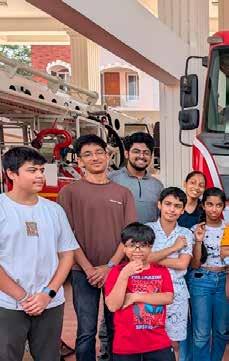
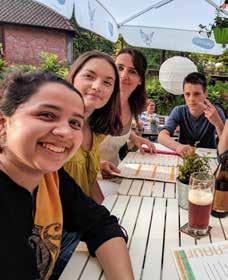
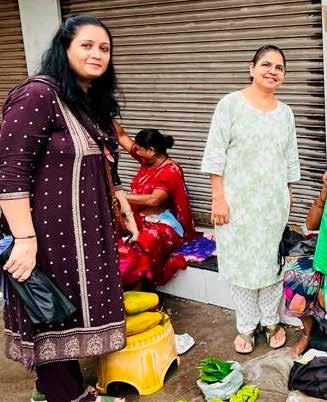
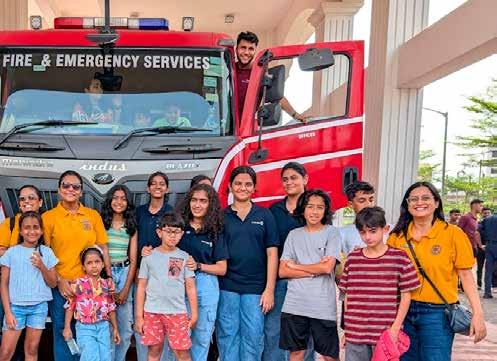
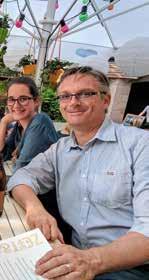
Clockwise from below: RAC Vapi Phoenix Beacons charter president Shreya Mehta and her family with Muriel Blum, an RYE student from Germany, at the Akshardham temple; Club members giving a food pack to a new mother; Distributing raincoats to street vendors; Shreya with her host family in Germany; Rotaractors and Interactors on a visit to a fire station.
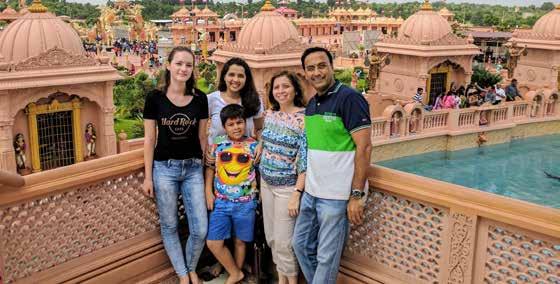
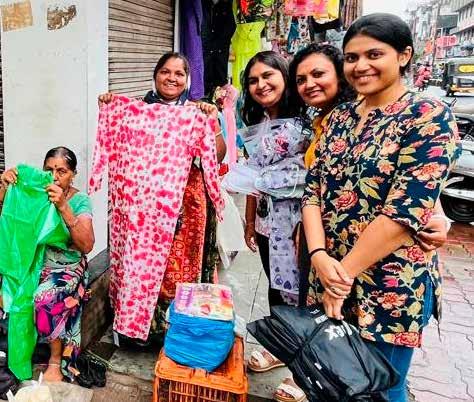
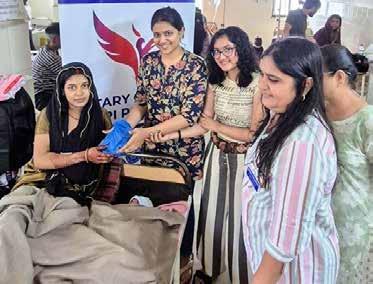
V Muthukumaran
Aiming to extend a bridge between art and youth, Project Kala Setu (art-bridge in Telugu) is painting the walls of government school, orphanages and special homes across Hyderabad with Rotary concepts and pithy messages, besides colourful landscapes, to inspire the students.
Giving an insight into the school project, RAC Hyderabad Corporate president Mounika Reddy, RID 3150, says, “Our wall paintings, murals and frescos will reach out to around 1,500 students at seven government high schools
and special homes. We will paint narratives and messages related to Rotary such as the Four-Way Test, Presidential themes, and images to create awareness on our fragile ecology and following good sanitation habits.” While the project is sponsored by their parent RC Hyderabad East, the Rotaractors are executing the project with a systematic planning.
They have already painted the walls at the Government Rotary Nirmal Bharath School, Panjagutta, and followed it up with a similar work at a juvenile home in Kachiguda, “where two
classrooms, a dining room and kitchen were given a colourful makeover.” A team of 56 Rotaractors, 18 from the executing club and the rest from other clubs, is doing the painting work as “we want to not only introduce art to students, but inspire them with some messages that reinforce Rotary’s brand as a global NGO.”
The club members bought rakhis (sibling threads) in bulk quantity from a wholesale market under Project Suraksha Bandhan , and “sold them to the public at the Indira and Dog Parks on the eve of Raksha Bandhan. We raised
RAC Hyderabad Corporate members at the Government Rotary Nirmal Bharath School, Panjagutta.
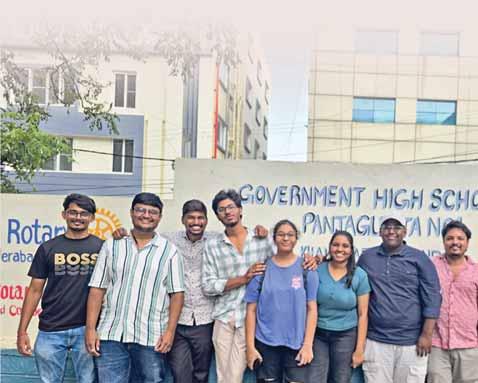

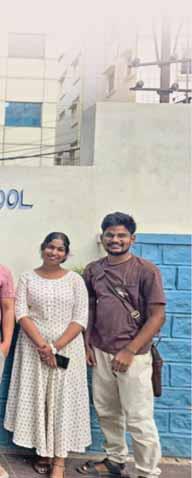
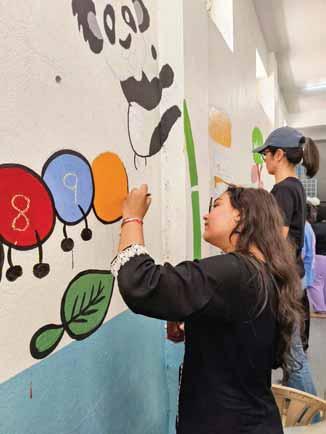
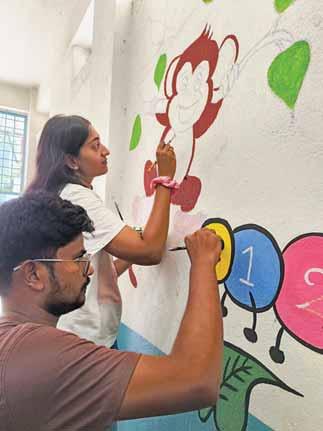
` 18,000 which will be used to distribute sanitary pads to underprivileged girls,” says Mounika. A mega ENT medical camp was conducted at a village near Hyderabad by a team of four doctor Rotaractors.
“We screened around 450 villagers, and free medicines were given to them.”
A CPR session was held at the Nexus Mall in which demos were conducted by Rotaractors on how to provide emergency aid to those hit by cardiac arrest. “I enjoy doing Rotaract projects,” says Mounika, an entrepreneur, recalling her two-year journey in the youth movement of Rotary.
She was a member of the Rotary Club of Hyderabad Metro City, “but had to quit after it was terminated in January 2025. Now, I am looking forward to join my parent Rotary by next year.”
She is heading RAC Hyderabad Corporate, a three-year-old community club, for the second consecutive year. “We are made
up of 29 Rotaractors, mostly working in the IT sector, and a few of them are also doctors and entrepreneurs,” she adds.
